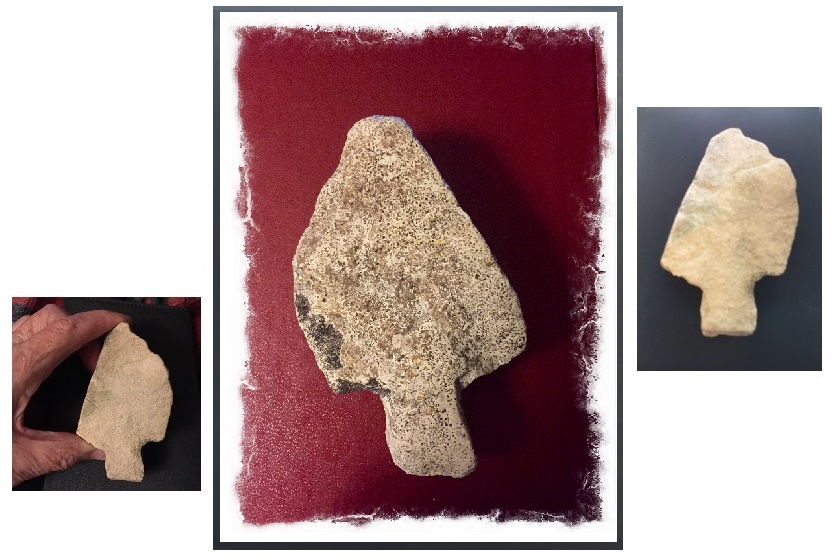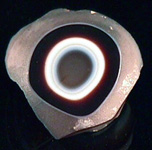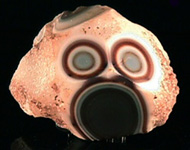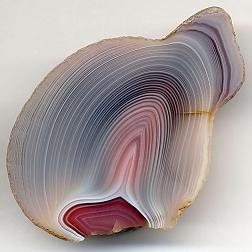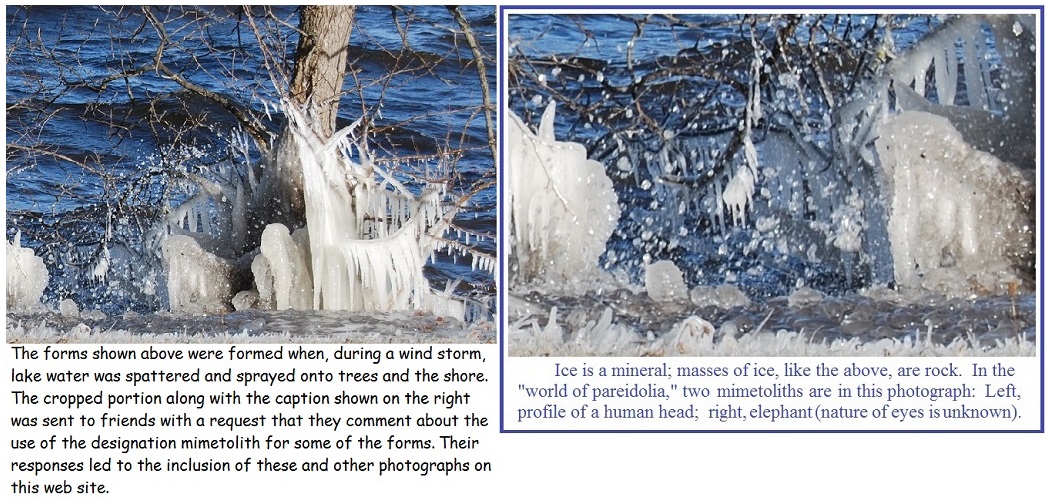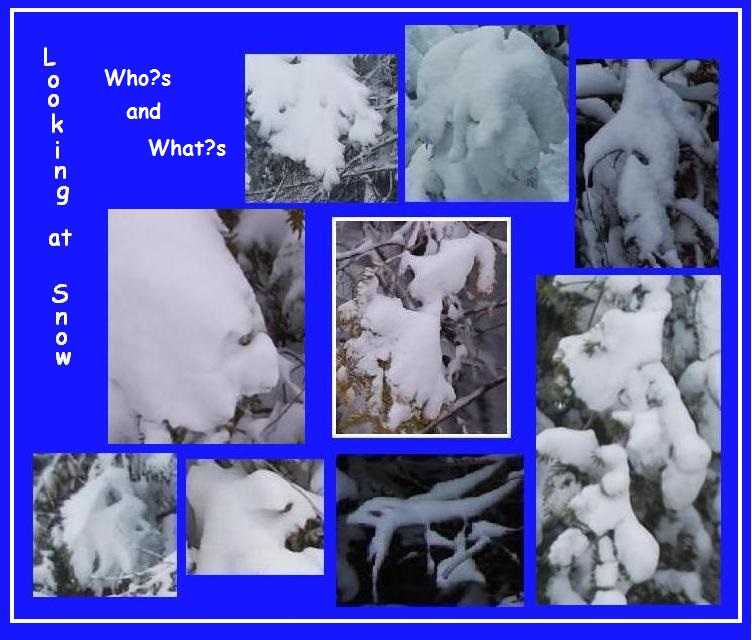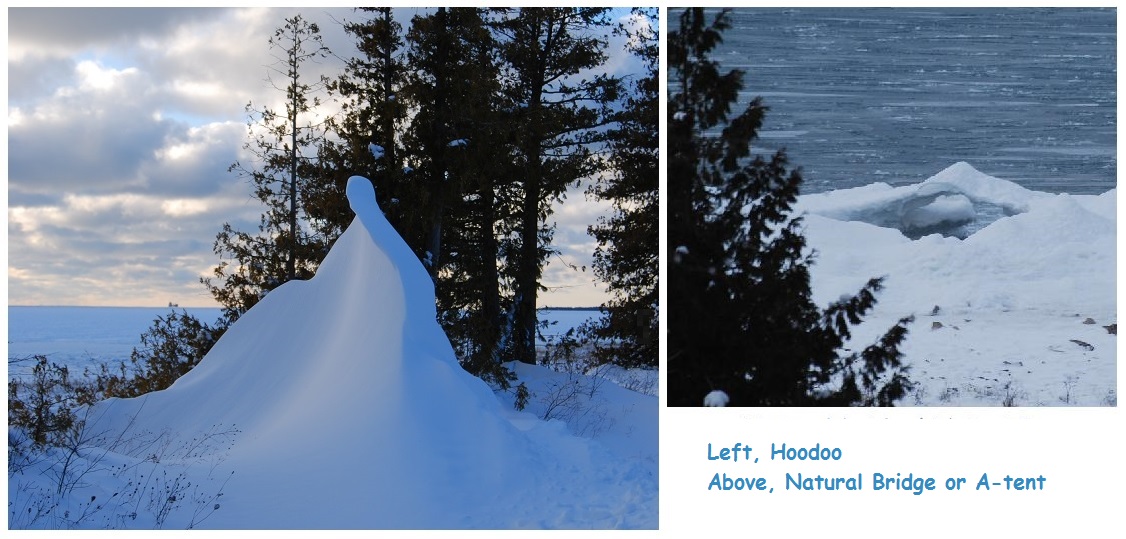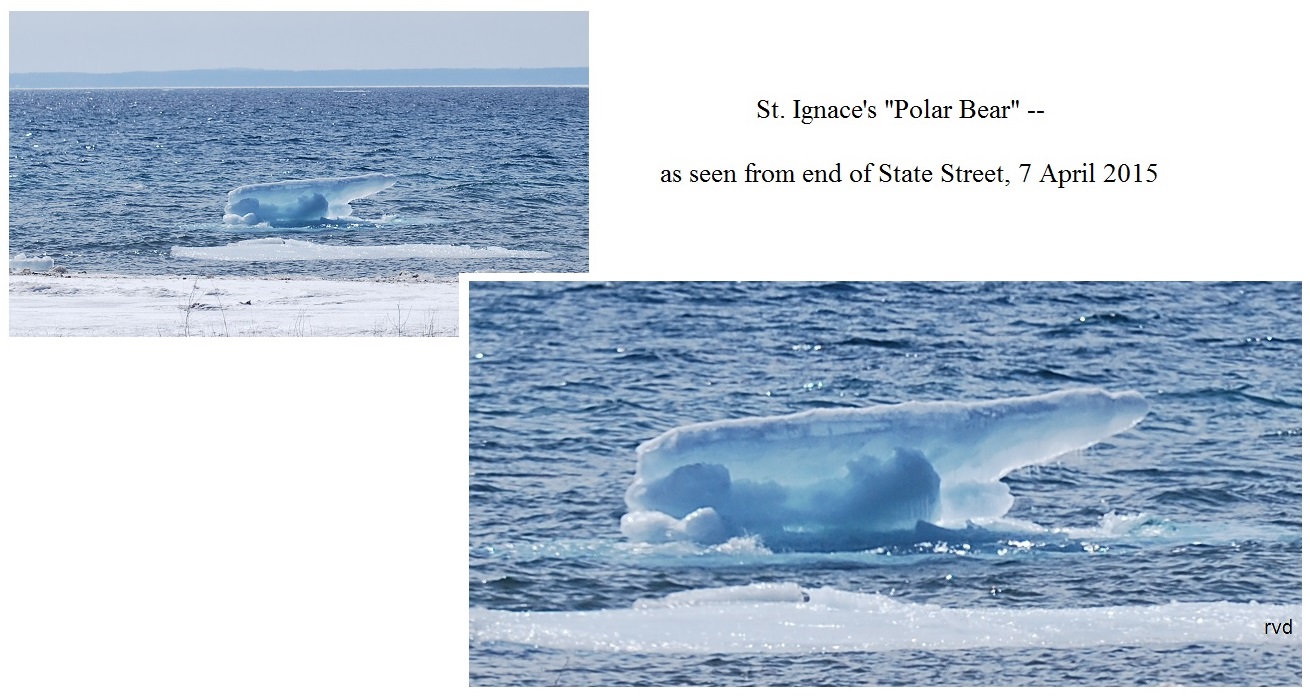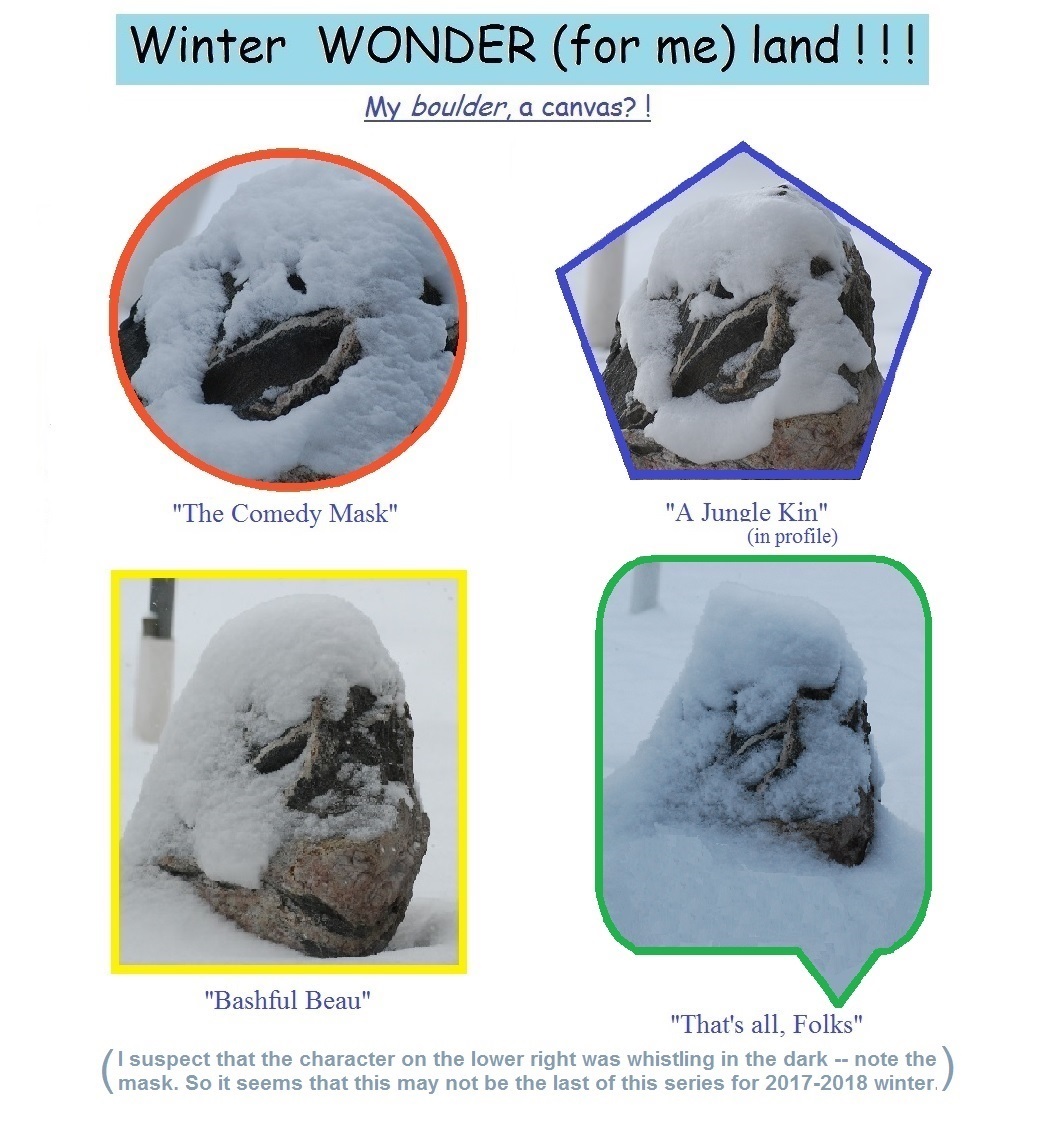MIMETOLITHS
Compiled by R.V. Dietrich
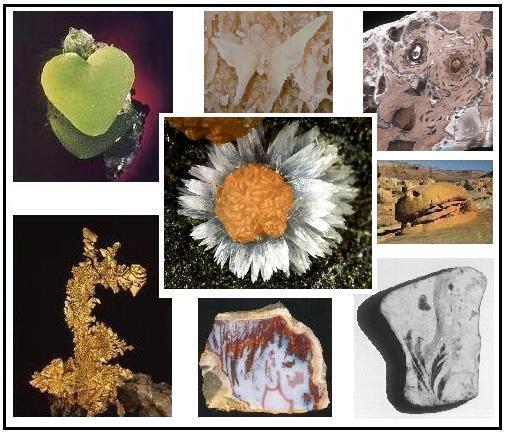
Last
update - 14 Jaunary 2018
Note:
Click
thumbnails to see larger images.
ADDITIONS, UPDATES
and
REVISIONS are being made continually to this site --
i.e., several have been
made
since a PDF file*/ was
prepared.
Captions for he
updates and
revisions appear in red.
Latest
additions: APPENDIX D.
Examples
of Ice and Snow
& entry 49a
-- last entry in Loose Stones group
[* A PDF file made in
2011,
which has NOT been UPDATED, was made available in CMU's CONDOR
repository; it has been "replaced ... with the CMU Libraries
Digital
Collections. . . . visit scholarly.cmich.edu." ]
INTRODUCTION*
Nearly everyone has, I
suspect, looked at one
thing and imagined it
looked like something else. Indeed, many observations of this
kind have been
recorded. -- Four examples are: the Chinese poet
Lo-tien (773-846)
mentions viewing stones (see www.bonsai-nbf.org/);
Shakespeare (1564-1616)
has Hamlet exclaiming about cloud shapes that resemble "a camel," "a
weasel," and "a whale" (Hamlet -- Act iii, scene 2);
Mark Twain (1835-1910) has Adam, in The Diaries of Adam and Eve,
lamenting
" . . . always that same pretext is offered -- it looks like
the thing.";
Robert Williams Wood (1868-1955) in his little book How
to tell the birds
from the flowers . . . (1917) provides several delightful
sketches and poetic
remarks that pertain to such observations; and, there are ,
of course, the implications, especially in some peoples' minds, that
relate mimetoliths and pareidoliatic
apophenia.
An EPILOGUE, which follows the acknowledgments
near the end of this text, includes much of the introduction that
appeared in Dietrich (1989) and a short paragraph about pareidoliatic
apophenia.
It seems prudent here to recommend users to view
the larger versions of the illustrations, which may
be seen by clicking
the thumbnails; some of
them show more than an enlarged version of the thumbnail. Also, anyone who knows
about other
features (s)he thinks
should be included, please contact me. This file will be
updated continually by
adding comments about and/or illustrations of noteworthy mimetoliths
not previously included
on this site.
_
* Some of the
text and a few of the illustrations in
this file were
published in the Rock Chips column in Rocks &
Minerals
(Dietrich, 1989).
DEFINITION +
mimetolith (mǐ·
mē·
tō·
lǐth) n. 1.a. a
natural
topographic feature, rock outcrop, rock specimen, mineral specimen, or
loose stone the shape
of which resembles something else -- e.g., a real or fancied
animal, plant,
manufactured item, or part(s) thereof. b. a topographic
feature, rock
outcrop, rock specimen, mineral specimen, or loose stone, the surface
pattern of
which resembles a real or fancied animal, ... . c. a
topographic
feature (et alia) with any combination of shape and
pattern that resembles a
real or fancied animal, . . . . [Greek mimetes
(an imitator) and lithos
(stone); term coined by Thomas Orzo MacAdoo,
first appeared in
(Dietrich, 1989).] Discussion: Some people
have applied this
designation to forms exhibited by minerals and rocks that have been cut
(e.g.,
sliced) or shaped (e.g., eggs and spheres) -- see, for examples,
Figures 32, 61-78 and AppB1-AppB9. Although
it has
been suggested that this is an
overextension of
the designation, it seems quite justified because natural weathering
and erosion could
have exposed the features that would have led to their being referred
to by this term.
So far as their origin, diverse mimetoliths
have
been formed as the result of solidification of magma, crystallization from solutions, chemical weather,
physical weathering, abrasion either in place or during transport,
etc., etc. as well as the result of several different combinations of
such constructive and destructive geological processes.
Three cautions/questions:
1.The
term mimetolith
should not be applied to terranes and exposures or to rocks and
minerals strictly
on the basis of such characteristics as their color, how they feel or
smell, or any sound
they emit when, for example, they are hit with another object or wind
blows across or
through them. Examples of each of these categories that should
not be called
mimetoliths are the minerals achroite (a variety of elbaite), kyanite,
purpurite, and
rhodochrosite; the rocks commonly called grease stone
(soapstone),
stinkstein (bituminous limestone), and phonolite (feldspathoidal
trachyte);
[and] "Whistling rock" near Esperance, Western Australian
and
"Roaring Cove" (if it actually exists), Newfoundland.
2. Welcome to the world of
equivocation/ambiguity.
During the considerations and discussions Dr. MacAdoo and I had before
we decided it
worthwhile to introduce the term, we tried to think about all the
diverse kinds of
features to which future observers might apply the term. Two things we
considered seem
noteworthy here: A) We do not think the term should be
applied to a mineral
pseudomorph (i.e., to any mineral mass that has the crystal form
of another mineral
rather than that characteristic of its own composition).
B) We had mixed
feelings so far as applying the term to all features called by such
names as natural
bridge, natural arch, natural tunnel and pothole -- I do not
think all so-named
features should be automatically considered mimetoliths; future
usage, however, may
dictate otherwise.
3. Because snow and ice are
considered minerals and/or rock, questions have been raised about
whether imitative forms assumed by, for example, fallen or drifted snow
should be considered mimetoliths.
Examples are given in Appendix D.
----------
>>>>>
<<<<< ----------
LANDSCAPES and
ROCK FORMATIONS
Features included under this subheading are
integral parts of their
environments. Although most features in this group are
large as compared to
the detached specimens included under the other subheadings, a few are
relatively small --
e.g., some of the cave formation mimetoliths.
One question, in particular, has arisen about
this group:
"Should such features on the moon, planets and other celestial bodies
included?".
My "off the top of my head" answer is a rhetorical question:
"Considering general application of geological nomenclature to other
bodies in the universe, is there any good reason not to include such
features?" See, for
example, Figures 1a, 1b and 2. On the other hand, I would not
include
such things as the following (directed to my attention by a friend who
keeps abreast this web site): "NASA's Hubble Space Telescope
captures a the [sic]
celestial equivalent of a geode in this gas cavity carved by stellar
wind. Real geodes are baseball-sized rocks that start out as
bubbles in volcanic flows." Among other things, this
quotation, a caption given for the accompanying photograph in the
Photo Gallery: Amazing Space Photos --
<http://news.aol.com
...> (accessed
3 Oct. '07) -- relates to general
ideas relating to geneses of the illustrated feature and one of the
hypothesized origins for
vesicles (Not geodes), rather than to appearances.
Another question has arisen about masses that
appear to be
mimetoliths but have been modified either to preserve or to enhance their
original
appearances. Two examples: New Hampshire's famous
"Old Man of the
Mountain," to which concrete, steel cables, and turnbuckles were
added to
preserve its shape -- i.e., keep the rocks in place;
and "The
Devil" near Kenora, on The Lake of the Woods in southwestern Ontario,
Canada, which I
have been told had its original shape changed to improve (enhance) its
mimicking
appearance, I presume by rough sculpting. In my opinion,
the "Old Man
. . ." is (i.e., was--see
caption for Figure 5) a mimetolith whereas "The
Devil" should not be so-designated. and medium
Large (and medium) sized features
Click
thumbnails to see larger images.
|
 |
1a. "The Face of Mars," a mesa (~1.5
km across) in the Elysium region of Mars. (photo P-1174-023, taken
July 25, 1976 by Viking I Orbitor; courtesy Conway W. Snyder).
Added 22 September 2006: For more recently taken photos etc., see http://www.esa.int/SPECIALS/Mars_Express/SEM09F8LURE_1.html [On July 8, 2009, I received an email
that indicates the location given and the illustrations are
"false, they are sketches." I have not been able to verify this
recently received information.]
More recently, Ian O'Neill (see
References cited) has
directed attention to the "Top 10 Weirdest Mars Illusions and
Pareidolia", especially a Floating Spoon.
|
 |
1b. "Rabbit on the
Moon," pattern of darker areas of full moon (circumferance-
10,864 km -- i.e.,~ 6790
miles) as seen from Chile. Clicked image consists of three
parts: Left to right, the Full moon, the "Rabbit on the
moon," and a glyph of the Mixtec culture of Mexico. It is
hypothesized that
"the Mixtecas probably saw a rabbit-like shape on the surface of the
full moon, and thus elaborated the glyph that represents the
moon as a rabbit." (Patricio Bustamante, personal communication, March,
2008). For an explanatory text (in Spanish), see http://rupestreweb.info/hierofania.html
|
 |
1c. "Peppered pasta," "bread sticks,"
"cinnamon
rolls" and "mashed potatoes sprinkeld with spices" are among suggested
names for this "field of spotted ... [sand] dunes
... near the Martian North Pole." The original caption for the
complete photograph (to see, click thumbnail), which spans ~3 km,
indicates this appearance to be ephermal -- i.e., during
thawing "Thinner regions of ice typically thaw first revealing sand
whose darkness soaks in sunlight ... [but] By summer, ... the entire
dunes will then be completely thawed and dark." (© Malin Space Science Systems, MOC,
MGS, JPL, NASA: from http://antwrp.gsfc.nasa.gov/apod/astropix.html, dated 31 August 2004 ). |
 |
2a. "Old Man of the Mountain" (also called
"Great Stone Face") is the age-old erosional remnant of granite is the
state symbol of New Hampshire.
Here shown on a 1955 commemroative U.S. postage stamp, it also is the
focus of the New Hampshire's $.25 coin of the U.S. sates series.
This granite profile (height ~12.5 m.), which jutted out as a cliff
from near the top of Cannon Mountain near Franconia Notch, was held
together for several decades by steel rods etc. until May 2,
2003, when it met a Humpty Dumpty fate. The fall, which destroyed
the profile, led to several diverse suggestions as to what might be
done to the remains -- see, for example, Susan Ager (Detroit Free
Press, 11 May 2003, p.K1). (© photo of stamp by
Malcolm Back).
|
 |
2b. "Grey Man of the Merrick" rock exposure on
the northwestern side of the NE-SW trending niche between Redstone Rig
and Craig Neldricken about 0.5 km southwest of the southwestern lobe of
Loch Enoch, about 18 km N.11o E. of Newton-Stewart in the
Dumfries and Galloway Region of the Southern Uplands of southwestern
Scotland. (© photo by Douglas E. Wilcox; see www.gla.ac.uk/medicalgenetics/gallery).
|

|
2c. Name:
Photographer, Algis Kemezys suggested: "Montezuma
Rock ... it
looks like it is a King with a crown of sorts." ¶ RVD'
response:
"I cannot help but think the locals have had names ... If so, I should include
it."
¶ Algis: " I so agree ... that the local
Indians would have names for such mimetoliths. I think in
some ways mimetoliths kick started the whole universe of gods. ... I will still try to dig deeper
and see if I can find some infor (sic) but I am no longer
there."
¶ If a locally used name is found, it will be
added. Location: Near LaManzanilla
Beach, which is on Tenacatita Bay of the Pacific Ocean, Jaliśco,
Mexico. (© photo by Algis Kemezys).
|
 |
2d. "The Sleeping Giant," a plump face and
body profile landscape that can be viewed along the northern edge of
the Helena Valley, Montana. (photo U.S. Department of
Interior, Bureau of Land Management). |
 |
2e. Human-shaped
landscape. View from road between Los Perales and Céspedes
of the upper Illapel River Valley in the Coquimbo Region, which is
north of Valparíso, Chile. For further
information about
this mimetolith, see the following web site (in Spanish): http://rupestreweb.info/entorno2.html
|
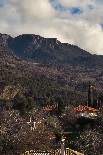 |
2f.
"Jan
from the Argonauts" or
"Giant Mountain Mimetolith": Names given by photographer, in part
because of the location of this feature. It is in Northern
Peloponnese, Greece. ... "not far from Argo[s] where the ships set sail
to attack Troy to get Helen back. This is also near where Jason and the
Argo naughts set sail looking for the golden Fleece." (Algis Kemezys,
p.c. 1 January 2014) . (© photo by Algis Kemezys). |
 |
2g. "von Hindenburg with his earmuffs on," an
erosion remnant of diversely colored sandstones of the Wasatch
Formation in Bryce Canyon, Utah.
(© photo by Dick Dietrich). |

|
2h. "Buttocks" -- The size is indicated by the two photos on the
clicked image; rock -- "seems to be Granite."
Location: "below house where they filmed the Night of the Iguana
with Richard Burton and Ava Gardiner ... in Mismaloya Beach, [Jalisco,]
Mexico." (/A.Kemezys) (© photos byAlgis
Kemezys).
|
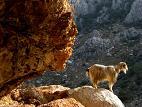 |
2i. The seven mimetoliths on the
clicked image are in Turkey. The one on the upper left and the
four in the bottom row are near the coast, ~7 kilometers south of Bayir
(Bayirkoy) in southwestern Turkey; the middle one in the top row
is near Oren in southern Turkey; the one on the upper right is
near Datça, which is down the penninsula, ~60 kilometers west of
Marmaris. The names given on the features on the clicked image
are mine (RVD’s). (photos ©
Algis Kemezys).
|
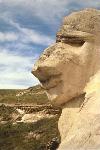 |
2j. Bandana(-topped) Man --
Part of an outcrop of
a cross-bedded sandstone of the Milk River Formation in Davis Coulee,
Writing-on-Stone Provincial Park in southern Alberta, Canada;
height ~20m along right margin of photograph.
(© photo by Rudi Meyer)æ |
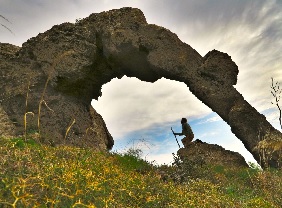 |
2k. "Elephant Rock" (Fil taşi in Turkish). This
natural arch, which consists of "basaltic(?) lava," is one of several
mimetoliths in the Black Rock Mts. of southwestern Turkey.
According to the
photographer, it is about 1.5 miles from the village
of Karakya and about five miles northeast of Gümüşlük,
which is on the Aegean Sea. (© photo by Algis Kemezys).
|
 |
2l. "Pyramid" near east shore of Pyramid Lake,
which is in the Pyramid Lake Paiute Tribe Reservation north-northeast
of Sparks, Nevada. Click thumbnail to see a
sketch of John C. Fremont's expedition "paused at the Pyramid in 1844"
and a recent photograph of more of the lake around the pyramid.
(© photo and sketch from www.nevadaweb.com/cnt/r-t/pyramid/,
permission of David W. Toll).
|
|
Sizewise the following mimetoliths are
the so-to-speak transitions between the
preceding large features and those shown in the "Rocks and Rock
Specimens"
group -- i.e., they are the ones referred to in the heading
to this group as "medium"
size features. |

|
3a. Lion
Head -- This is one of
a number of mimetoliths in the igneous terrain along the path to the
aquarium south of the Bitez Boat Harbor , which is just north of
Bodrum, southeastern Turkey. The feature is said to be "almost
life
size." (© photo
by Algis Kemezys)
|
 |
3b. "Sidney
Sphinx" -- "The eagle head image is
about two feet [~60 cm] high from top of its head down to the rocky
base. ... The rock is sandstone. ... [It is on the] rocky
islet ... locally called 'Ship Rock' and it's part of The little
Group, off Tsehum Harbour just north of Sidney, BC on the Saanich
Peninsula of Vancouver Island. Ship rock is about halfway betwen
Ker Island and Dock Island." (Paula Johanson, personal communication,
August, 2009). To me, there is yet another mimetolith in
this view -- see the head near the base of the "sphinx."
(© photo by John W. Herbert)
|
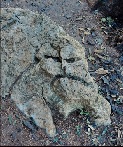
|
3c.
"Janus": The name
given by photographer "because it has two faces ... [one] looks like a
profile by itself but the whole makes the face complete. I named
it Janus because of the two faced Roman God. It is located
halfway between the town of Vathy, Ithaca and the Cave of the
Nymphs [Ithaca Island, which is in the Ionian Sea, and of the
Prefecture of Kefalonia]. I found it because I left the road to
go down to pet a dog and found it where in the pen where the dog
was chained. ... It is the size of a sled, or a medium sized dog.
2.75 feet by 1'." (© photo
by Algis Kemezys) ¶ Kemezy's
remarks about dogs led a couple of us who viewed this photograph before
it was added to this web site to refer to it as Leo (the Lion) because,
to us, it roughly resembles a Shih Tzu.
|
Others in the literature: Several natural
features
that occur
sporadically on our Earth have been given names that support their
status as mimetoliths.
Three of the larger ones are the "Horn of Africa" -- i.e., the Somali Peninsula of East
Africa that so-to-speak juts into the Arabian Sea, which was apparently
so-named because its shape was seen to resemble that of a
rhinoceros horn; Italy, the peninsular
country that extends into the Mediterranean Sea, with its widely noted
boot shape; and Michigan's lower peninsula,
which is frequently
referred to as a mitten. A
few of literally scores of examples of relatively large mimetoliths,
like those shown in figure groups 1 and 2, above, follow:
Cathedral Mountain -- the one west of
Lake
Louise, Banff National Park, Alberta, Canada (see www.cathedralmountain.com/).
Chimney Rock -- the one south of the North
Platte River, southeast of Scottsbluff, in western Nebraska (see www.nebraskahistory.org/sites/rock/)
Chinaman's Hat -- the name given to Mokolii
Island, chiefly basalt, which is about a quarter of a mile offshore of
Kualoa Point, Oahu, Hawaii. (see en.wikipedia.org/wiki/Mokolii}.
Devil's Postpile -- columnar basalt along the
John Muir Trail about 10 miles southeast of Yosemite National Park,
California; note also that the eroded top of this mass is
referred to as "Mother Nature's Tile Floor." (see www.choisser.com/gallery/posttour.html).
Elephant Foot glacier -- this feature consists
largely of glacial ice (a rock!). It is located on the east coast of Greenland (80.5ºN latitute, 18ºW longitude). (see the form as photographed in July 1997 by
Philippe Huybrechts on the internet -- http://homepages.vub.ac.be/~phuybrec/images-big/elephant.html). So far as I
know, the current appearance of the form has not been described or
photographed.
Ewuana or Face Rock, which is off
shore in the Pacific Ocean about a mile south of Brandon, Oregon, has a
profile that closely resembles the profile of a female's head.
See http://pdxsurr.blogspot.com/2006_01_01_archive.html
for a photograph and some Coquille Indian lore about this formation.
Fairy chimneys -- basalt-capped tuff erosion
forms in the Cappadocia region of central Turkey: Some resemble
Saturday Night Live's "coneheads;" others look more like
mushrooms. (see www.hat.net
and www.villacappadocia.com).
"Fairyland" -- described as "1,000
grey sandstone sentinels of fantastic shapes": Photographs
show
"The Sea-horse," "The Vulture" and "The Wolf," and mention The
Camel" and "The Sitting Hen." The area is located near the
edge
of the Klein Drakensberg escarpment of the Kruger National Park,
in the Graskop area of Mpumalanga, South Africa. (see www.graskop.co.za/jock/index.html).
Fort Rock -- an ancient volcanic crater, near
the town of Fort Rock, northwestern Lake County, 0regon, that looks
like a citadel with one of its sides breached (see www.wukkisorubgsqyestranch.com/fortrockpix.html).
Goosenecks -- especially those of the San Juan
River, west of Mexican Hat, southeastern Utah (see www.desertusa.com/goout/du_goout_vvc.html#anchor737098
and the lead
photo on www.magnum-hd.com/RoadTrip9c.html).
Guardian of Deseret -- sometimes referred to
as "naturally carved" lava, this feature, in Millard County, Utah, was
apparently seen by early Mormons to resemble Joseph Smith, their
founder, in profile (see geology.about.com).
Hopewell Rocks -- billed, especially in travel
brochures, as the "world's most famous flowerpots," these erosional
remnants, which are in the Bay Fundy of New Brunswick, Canada,
apparently owe their shapes to erosion by what are widely called the
world's highest tides -- i.e., those with the greatest height-wise
difference between the low and high tides.
Kannesteinen
-- sometimes called "pot rock," is a wave eroded feature on
Vågsøy, which is about 10 km west of Måløy on
the west coast of Norway
(about twothirds of the way from Bergen towards Alesund). It is
shaped
like a goblet or a mushroom, the latter of which in the local parlance
were called "kannes." Several photographs of this rock are
displayed
on internet web sites.
"Lincoln's profile" -- topographic profile
exhibited by a group of mountains west of Route 54, north of Van Horn,
Texas.
Little Flowerpot -- a lake-eroded stack near
the shore of Flowerpot Island in Lake Huron, near Tobermory, Ontario,
Canada: In order to preserve this tourist attraction, Parks
Canada has shored up the open lake side of this mimetolith and
so-to-speak paved the top of it with asphalt. (for photographs,
see www.marineinsureservices.com/Photos3;
for
sketch, see ndtoth.tripod.com/nicksphotos/id4).
Lot's wife
--Some of the “pillars of salt” of Mt. Sodom, which is southwest of
the Dead Sea, have long been looked at, and “Ancient
tradition thought it could fully identify the encrusted remains of Lot’s wife” (Plaut, 1981).
[See Genesis 19:26 where it is written that Lot’s
wife looks back at the burning cities of Sodom and Gomorrah and is
“thereupon turned into a pillar of salt.”] It is known,
however, that
the shapes of these so-called pillars have been and continue change
with the climate: At times, new salt has been added; at other times,
disintegration has occurred. In any case, at just about any time
at
least some of the “pillars” are mimetoliths. As noted in his
commentary on The Torah, Plaut (ibid.), “To this day,
salt-encrusted
rock formations in the area suggest all manner of shapes.”
Mollys Knob (locally
called "Molly's Nipple")
-- a prominence underlain by shale in Smyth County, southwestern
Virginia.
Pair of Mittens -- "East and
West
Mitten Buttes" in Monument Valley, northeastern Arizona (see www.americansouthwest.net/utah/monument_valley/mvbutte.html).
Pancake Rocks -- along the shore of Paparoa
National Park, about 55 km southof Westport, on the west shore of South
Island, New Zealand consist of differentially weathered alternating
layers of limestone and mudstone (see, www.dingwerth.de/Bjoern/photography/nz_1999/pancake)
Plumbers Rock (also called Buttcrack Rock) is
a rather large boulder that is so-named by locals in Hemet, in the San
Jacinto Valley of Riverside County, southern California.
The person who directed my attention to this
mimetolith, and I agree, noted that this is not only a fitting name but
also is humorous. As she said, "Mother nature is a cool chick!"
Pulpit rock -- as a child, I was shown one
near Oxbow, Jefferson County, New York; while a Fulbright
Research Professor in Norway, I saw the world-famous one, described as
a "natural rock formation with a 25 meter squared plateau [that] stands
604 meters above the sea" on the south side of Lysefjord, in Rogaland
county near Stavanger. (see www.stavanger-web.com/touristinfo/prekestol.htm);
others are
relatively common here and there around the world.
Shiprock -- a volcanic neck in northwestern
New Mexico. The Navahos, to whom it is sacred, see it
otherwise -- they call it Tse Bi dahi ("Rock with Wings");
the resemblance they see includes the dikes that extend outward from
the central neck; the sacred aspect stems from an ancient legend
that has the rock representing the great bird that transported
ancestral Navahos to the area.
Sugar Loaf (Pão de Açucar) --
the granite porphyry dome in Guanabana Bay, Rio de Janeiro, Brazil (see
www.peakware.com/encyclopedia/peaks/photos/sugarloaf).
Teapot rock (Wyoming) -- this mass, which
gained its notoriety because of the Teapot Dome scandal of Warren
Harding's presidency, no longer has its spout (see before and
after photographs on Andrew Alden's web site - geology.about.com).
I have often wondered what Native Americans called this rock
before teapots came onto the scene.
Tent rocks -- conical teepee-shaped erosion
remnants -- some up to 90 feet high -- in Recent volcanic debris
(chiefly pumice and tuff) of the Jemez volcanic field, near the Cochiti
dam, about 35 miles west-southwest of Santa Fe, New Mexico. In
2001, Kasha-Katuwe Tent Rocks National Monument was established to
assure preservation of these forms and the surrounding area. (For
photographs showing these forms see the web site kevingong.com/hiking/TentRocks.htm.)
The Hunter and His Dog (sometimes referred to
as The Old Man and His Dog) and other rock outcrop features given such
names as Elephants Head, The Singing Bird, and The Smuggler can be
viewed from or near Vermont Route 108 in the Smugglers Notch area
northeast of Stowe, Vermont
Three gossips and the "parade of elephants" in
Arches National Park near Moab, Utah are two of my favorites among
these relatively large mimetoliths.
Totem Pole -- this feature and several other
erosional forms, many of which resemble people and animals, occur in
chiefly volcanic rocks at Chiricahua National Monument, southwest of
Willcox, southeastern Arizona. The "duck rock" and "organ pipes"
are other especially noteworthy mimetoliths in this National Monument.
.
Whale's Back -- a small island in the Saint
Lawrence River, southwest of Oak Point, Town of Hammond, St. Lawrence
County, New York.
Whiskey Island (of the Beaver Island Group of
northern Lake Michigan) -- Lore has it that the kitelike shape of this
island led to its name because of the old saying that one who has drunk
much whiskey is sometimes "higher than a kite."
Whale's Back (next to last on the preceding
list)
-- from which I
fished as a youngster and later mapped while working on my doctoral
dissertation -- served
as an early incentive, so far as spurring me on, to look at profiles of
islands,
mountains, inter alia, to see if they might remind me of
anything else. Subsequently, I have enjoyed looking for
(and finding!!)
mimicking
shapes exhibited by many landscapes -- especially mountainscapes and
seascapes -- here and
there around the world. The fact that several people have "seen" such
resemblances led to compilation of the Minnesota Museum of
Mississippi's database,
presented as the "Stone Faces Gazetteer" on the internet (see
http://www.mnmuseumofthems.org/Faces/Index.html). That site
gives locations and a
few photographs, of natural mimicking features -- faces, profiles
involving cliff faces
and other outcrops and boulders (some enhanced by, for example, paint
to exhibit more
clearly the "seen" feature), and other anthropomorphic features
including
several "sleeping giants" -- most of which are in the United States of
America. Two additional web sites of interest so far as these
kinds of mimetoliths
are "'Indian Heads' and other humanoid rocks" (http://astro.wsu.edu/worthey/astro/html/im=indian-heads/indian.html)
and "Stone-Faced Sober," which shows several examples in the
Laurentians north
of Montreal, Canada (http://www.pbase.com/alkeme/stonefaced_sober).
Speleothems (i.e.,
cave formations), many
of which are
mimetoliths, occur in many caves throughout the world. Examples of
fairly common
speleothems that have been given names indicating what they resemble
include the following:
angel hair, bacon strips, draperies, frostwork, honeycombs, parachutes,
shields, soda
straws, and veils; flowers, needles and pearls (usually preceded
either by the word
cave or the name of the component mineral, as an adjective). In
addition, several
commercial caves feature formations to which they have given names such
as "The Great
(Pipe) Organ," "Christmas trees," and "Eagle's nest." Of
these latter, less common forms, my favorite is "Abraham Lincoln's
Profile" in
Longhorn Cavern State Park, Burnet, Texas. Many of these
features can be seen on
web sites that list caves/caverns/grottoes.
Speleothems
Click
thumbnails to see larger images.
|
 |
12. Draperies
and bacon rind
speleothems (no
dimension specified) in
Wolf River Cave (known locally as "Blowing Cave"), Pall Mall,
Tennessee, near the estate of the famous Alvin C. (Sergeant) York.
(© photo by Jay Greene, courtesy James Greene). |
 |
13.Bacon
rind, calcite
speleothem approximately 15 to 30 cm wide on the inclined ceiling of
the entrance room in Las Grutas de Bustamante, Bustamante, Nuevo
León, México. (courtesy of Thomas Shimer and
Shannon
Woodward, Texas A&M University at Galveston Biospeleology class,
2002). |
 |
14. Cluster of soda straws (no dimension
specified) in "A Classic TAG
["TAG refers to an area of heavy concentration of caves located at the
junction of the states of Tennessee, Alabama, and Georgia, USA."]
Commercial Cave." (© photo by Jay Greene, courtesy James Greene). |
 |
15. "Frostwork
on popcorn and
boxwork" in Wind Cave, Custer County, South Dakota. Remarkably,
the crystals and
"popcorn" resemble two kinds of frost per
se that I saw while spending a
year in Norway; although a native of the St. Lawrence River
Valley of northern New York, where plants (etc.) are frequently frost-covered,
I had not previously seen popcorn-shaped
frost. (photo by Keven
Downey & Urs Widmer, from the Wind Cave National Park
Service
web site
-- http://www.nps.gov/wica/
). |
 |
16. Gypsum flower (size not specified)
in "A
Classic TAG
Commercial Cave." (© photo by Jay Greene, courtesy James Greene). |
 |
17. "Butterfly"
("wing span" ~ 22 cm) helictite in the Caverns of Sonora, Sutton
County, Texas. --Helictite is the name given
stalactites whose growth are controlled largely by forces other than
gravity. (© photo by Jack Burch, courtesy of the Caverns
of
Sonora). |
MINERALS, ROCKS and
STONES
Most mimetoliths included in this group are in
museum and private
collections or on beaches, in gravel pits, etc. -- several of the
illustrated examples
representing the last two environments were photographed and left for
others to collect
should they want them. The stone
called "Eternity" is of particular interest
so far as this group of mimetoliths: It is about fist-sized, resembles an old woman's face and is said to be "worth 96 million yuan (US$12
million)" (see http://english1.peopledaily.com.cn/200406/29/eng20040629_147918.html). Whatever, the
mimetoliths consdiered in this group are smaller than
most of those
mentioned and illustrated under the preceding subheadings.
Many mineral and rock specimens that can be
designated as
mimetoliths have undergone preparatory procedures -- e.g.,
extraneous material has
been removed. However, the original shapes, which comprise their
mimicking
components, have not been altered by those procedures. Cross-shaped
twinned crystals of
staurolite are probably the most widely known examples of mimetoliths
of this category.
Although some of these crosses occur loose where they have
weathered out of their
host rock, many have been freed from their surrounding minerals by
collectors and
preparators. These mimetoliths, which resemble either Roman
and Maltese
crosses are frequently referred to in the vernacular as "fairy stone
crosses." Along this line, it seems noteworthy that
staurolite's
commonly
occurring as cross-shaped twinned crystals led to its name, which is
based on
the Greek word stauros (meaning "cross"). One noteworthy example of a mineral
mimetolith that is not shown here is "Bird Wing." Described as a
"Shimmery, dusty-rose piece [of hematite] from the English Midlands," it is illustrated by a
fine photograph in "Audubon"
(magazine, September-October 2012, p.76). For the record, the
specimen, now
in the Academy of Natural Siences Museum in Philadelphia, Pennsylvania,
is said to have been collected by William S. Vaux.
Another mineral that perhaps should be added here is OKENITE, which is
often even referred to or described by terms such as snowball and
puffball. To date, I have been unable to find one to photograph
or anyone to contact to get such a photograph -- perhaps someone
viewing this web site will have one, that warrants photographing and
inclusions in this group.
ineral Specimens (Dana System order)
Click
thumbnails to see larger images.
|
 |
21. "The Dragon" (height - 11.5 cm), gold
from the Colorado Quartz mine, Mariposa County, California is said by
Jeff Scovil to be the finest gold specimen on matrix in the
world. Houston Museum of Natural Science collection. (©
photo by
Jeff Scovil). |
 |
21a. "Auric Geezer, the old prospector"
[R.V.D.'s
designation] (height - 5.8 cm) gold specimen from Khoral
deposit, Tuva (+Charal, Tuvainskaja A.S.S.R. in some atlases), which is
approximately 500 km east of the southwestern tip of Lake Baikal,
Russia. Specimen is in Fersman Mineralogical Museum of the
Russian
Academy of Science, Moscow, Russia -- see Leibov, 2004. (©
photo by Michael Liebov). |
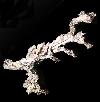
|
22. "The
Tyrannosaurus Rex
Silver" from near Rockland, Ontonagon County, Michigan (longest
dimension, ~11.5cm).
This
photograph has been used by Western Minerals
in its advertisements -- e.g., on
page 348, volume 87
of "Rocks &
Minerals" (©
photo courtesy Western Minerals,
www.westernmineralsaz.com). |
 |
23. "The Buffalo" (height ~ 14
cm) – silver crystals and native copper from the Calumet and Hecla
mine, "most likely one of the Kearsarge mines or the Wolverine mine".
John T. Reeder collection, #1726, A.E. Seaman Mineral Musem, Michigan
Technological University. (© photo by George Robinson). |
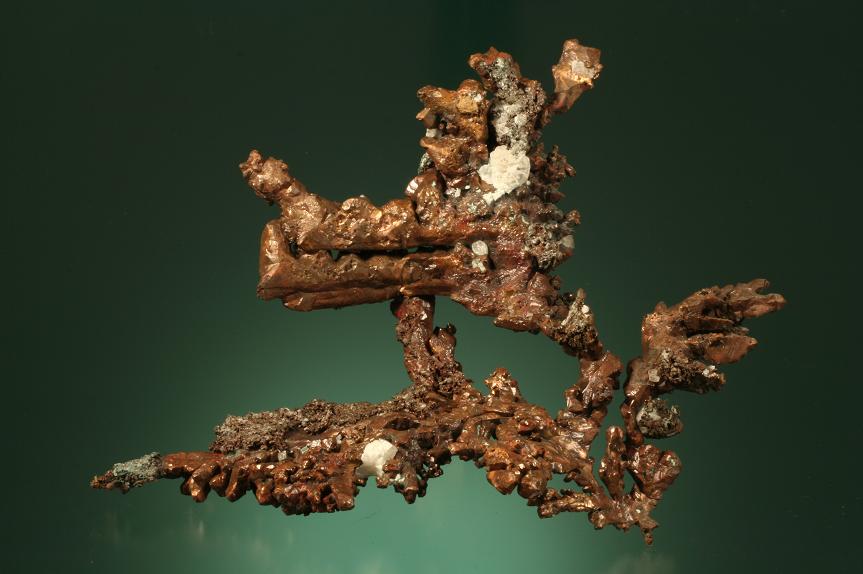 |
24. "Gamboling – Fast and
Free" (18 x 13 cm) – copper crystals from the White Pine mine,
Ontonagon County, Michigan. Benjamin Webb donation to A.E. Seaman
Mineral Musem, Michigan
Technological University. (© photo by John Jaszczak). |
 |
24a.
"Elvis" –
"!0.5-cm. cluster ... copper crystals from Michigan ... " see
clicked image, which includes the complete caption and additional
information. (photo by Richard
Jackson; permission to include here,
Collector's Edge Minerals, Inc.; first published in The Mineralogical
Record,
January/February, 2011, p.4)
|
 |
25. "Sir Walter Raleigh and his first cigar"
(height ~ 6 cm)
– nodular "psilomelane" from Crimora
mine, Augusta Co., Virginia. (© photo by G.K. McCauley). |
 |
26. Plane-bounded "Heart"
(height ~3.2 cm)
– twinned calcite, which exhibits phantoms, from Fivemile Point,
Keweenaw County, Michigan; specimen found by Bob Williams in 1975
is currently in the Pam and Jerry Hall collection. (©
photo by John Jaszczak). |
 |
27. "The Snail" (width - 8
cm),
rhodochrosite on
crystallized manganite from the N'chwaning Mine in Kuruman, South
Africa. Bill Larson collection. (©
photo by
Jeff Scovil). |
 |
28. "Heart" (width -1.3 cm) of smithsonite
from San Antonia El Grande Mine, Chihuahua, Mexico. (© photo by Gabriele L. Berndt). |
 |
29. "Onion dome on a Russian church"
(4.3
cm high) – "Malachite ...
from Kerouchen, Morocco. Heliodor
specimen Wonderful aesthetics and an uncanny resemblance to
an onion
dome on a Russian church" (Scovil, 2010, p.139) (©
photo by
Jeff Scovil). |
 |
30. "Candelabra" (overall size ~ 25
x 23 x 15 cm) – red, white, and blue, color-zoned tourmaline (elbaite)
crystals with quartz, albite and lepidolite from the Tourmaline Queen
mine, near Pala, San Diego County, California. NMNH #132377. (©
photo by Dane Penland; courtesy of the Smithsonian Institution).
A photograph of another fine predominantly tourmaline and quartz
mimetolith, the "Steamboat," may be seen in Dietrich (1985 -- Plate IV,
Figure IVb )
|
 |
30a.
"Hedgehog"
(greatest dimension ~4 cm) – natrolite from vug in pillow basalt,
Robertson Pit, near Dayton, Mason County, Washington. Additional
information about the specimen is on the following web site:
http://www.washingtonminerals.com/rp.htm. (©
photo by
Jeffrey Schwartz).
|

|
30b.
"Snowball"/or/"Puffball" (diameter 4 cm) - natrolite
from Prospect Park, New Jersey, in collection of the Department
of
Geology, St. Lawrence University, Canton, New York. (©
photo by George Robinson).
¶ This entry has been added in response to viewers
inqueries asking why an Okenite "snow- or puff-ball mimetolith"
was not included in this compilation. The attached natrolite
seems to fill this deficiency until someone supplies an okenite
example.
|
Although most of the mimetoliths illustrated in
the Loose Stones, Miscellany and À la carte
groups are rocks, only those shown here as Figures
31
through #39a seem best
designated simply as Rocks and Rock Specimens.
Rocks and Rock Specimens
Click
thumbnails to see larger images.
|
 |
31. "Owl eyes" (width ~16 cm) is
orbicular granite from the Matopos Granite, near Rhodes' Grave,
Zimbabwe (formerly Rhodesia). Owl collection of Margaret Gibson,
Corlette, New South Wales, Australia. (© photo by Craig
Gibson). |
 |
32. Graphic granite: Left,
sphere (diameter - 9 cm) from the Little Three mine, Ramona, San
Diego County, California; right, plane surface of a specimen,
locality unknown. Patterns exhibited by these rocks are
widely described as resembling letters of the Hebrew and Arabic
alphabets or cuneiform inscriptions; indeed, non-English names
that are given these rocks in several languages reflect this perception
-- e.g.,
French - pierre hébraïque
and German - Schriftgranit.
(© photos by David London, University of Oklahoma). |
 |
33."The Fallen Queen" the shape of which
resembles that of a queen chess piece; length of slab (clicked
image) - 12.5 cm; the entity in the thumbnail "seems to be a
fragment of a crinoid column, probably from near the top of the column
where it joins the crown. The alternation of wide and narrow
columnals [(stem segments)] occurs in several genera and quick perusal
of the Treatise volumes suggests that the specimen may have been a
member of the Flexibilia. All the debris in the slab is
echinodermal, with various fragments and orientations of columnals."
(J. Thomas Dutro, Jr., personal communication, 2007). The
slab is said to have been collected from Lower Pennsylvanian strata
exposed
on the C.B. Lambert Ranch at San Saba in central Texas. (©
photo by
Mel Hixson). |
 |
34. "Wow! -- I am startled." polished slab
(greatest dimension -15 cm) of Cycadoidea armor showing cones with leaf
bases. From a conglomerate of the Cedar Mountain Formation northwest of
Moab, Utah. (© photo by Richard Dayvault). |
 |
35. "E.T." weathered
surface of a block (width ~ 40 cm) of a silificifed concretionary
sandstone, termed "swirly sandstone" by Dayvault and Hatch
(2005),
of the Cedar
Mountain Formation just west
of Arches National Park, northwest of Moab, Utah. (©
photo by
Richard Dayvault).
A Second One is shown on the
clicked image: "E.T. winking at you" or "E.T. with
eyepatch" a cobble (height ~ 7.5 cm) of dolostone from a pit
southeast of Rudyard, Michigan. (©
photo by Dick Dietrich) |

|
35a. "Stone face" (=
DOĞAL TAŞ YÜZ) -- specimen (6.5 x 7.8 cm) picked up in "karain
cave" Antalya, Turkey. The specimen is designated as jasper by the
owner; according to a report of the Ankara University Earth
Science Application and Research Center, the rock "is mainly composed
of chalcedony, trydimite and quartz minerals." The owner
notes that "I am sure the stone face is formed by natural
processes" (H.B. Bostanci, p.c. 2012), and, in additional
responses to my inquiries, he has said that it shows no sign of carving
or
other kind of fashioning by humans. (©
photo by H.B. Bostanci).
|
 |
36. Butte -- Potsdam Sandstone
cone (width - 25 cm) formed either as shear cone during post-glacial
doming/sheeting or as the result of man-imposed percussion.
Specimen from Michael W. Johnston of Hammond, St.
Lawrence County, New York. (©
photo by Dick Dietrich). |
 |
37. "Between Worlds" (height
~ 20 cm), noted as "A convergence of cultural and religious symbology."
An unidentified rock exposure in Santa Monica Mountains, near Ventura,
California. (©
photo j. Madison Rink, http://www.rinkarte.com/PrimitiveNature/TheShaman.html).
|
 |
37a. "Tribal Island:
existential sleep" (height ~ 40
cm; width ~ 12.5 cm) An unidentified rock
exposure in the Santa Monica Moutains, near Ventura, California (©
photo j. Madison Rink, http://www.saatchi-gallelry.co.uk/showdown/
index.php?showpic=204022 ). This photograph is
described as "inspired and influenced by the
antique
tribal and Asian Art created by the aboriginal peoples from around the
world." To me, there is something Easter Island about it -
a primitive power(?).
|
 |
38. "Monkey's face" (leaves give
scale). This mimetolith consists of three juxtaposed
stromatoliths in the Cambrian Hoyt Limestone in Saratoga County, New
York. They are preserved in Lester Park, a natural history site
of the New York State Museum. Attention was directed to these
stromatolites by John Steele, in 1825, in his notes about the mineral
waters of the famous springs of the area. I first
found out about them some 70 years ago, while talking with Winifred
Goldring,
then state paleontologist of New York State. (© photo
courtesy Wendell Mohr). |
 |
39 "Human footprint" mimetolith (knife
gives
scale) in unidentifed rocks said to be more than 100 million years old
in Oklahoma --see
Monroe, 1987. (© 1975, Oklahoma Today magazine. Reprinted
with permission). |
 |
39a Kikkaseki, "stone/rock of
chrysanthemum flower" ("flower" width ca. 2.7 cm), from Gifu
Prefecture,
central Japan -- a metamorphic rock that contains clusters of carbonate
crystals (dolomite, calcite and/or aragonite) arranged in a radial
manner. (© photo courtesy Nobuo Ishihara). |
Most stones that are viewed as mimetoliths
are tektites or
beach- or stream-abraded stones; a few are ventifacts -- i.e.,
stones
that have undergone wind erosion. All of those illustrated are
just as they were
picked up -- i.e., they have undergone no preparatory
procedures.
Several resemblance-based adjectives are applied
to tektites.
In most cases, each is followed by a hyphen and the word
"shaped."
Along with those noted in the caption of Figure 40, additional
fairly common
designations include ball, bean, bowl, button, disk, gherkin,
hourglass, mushroom, and
pear as the first word of the hyphenated adjective -- e.g.,
ball-shaped . . . .
Tektites
Click thumbnail to see larger image. |
 |
40. Tektites. Upper row (left to right) -- peanut-shaped
indochinite; lens-shaped
australite
(diameter - 2.4 cm), typical of those formerly called "emu eyes" by
Australian aborigines and "Blackfellows' buttons" by some of the
early white settlers of Australia; dumbell-shaped phillipinite;
and cudgel-shaped
australite. Bottom row -- diverse teardrop-shaped
tektites from different localities. (© composite
made
up of images from a photo by David Britain). |
Several water worn stones, ranging in size
from small pebbles
to large boulders, have shapes that resemble other things. Also,
as already
mentioned, some loose stone mimetoliths are ventifacts. The ever
increasing list of
things "seen" as imitated -- along with those noted in captions of the
illustrations -- include the following, each of which I have seen or
otherwise verified:
ape's head, coins (discs), eyes (e.g., thomsonite
"eyestone"
pebbles), a heart, "Indian beads" (e.g., segments of fossil
crinoid
"stems"), a Laplander's hat (or shoe), a loon, a man on a donkey, a
number of
letters (e.g., F, S, & D – see illustration in the GNEISS
entry of the
"GemRocks . . ." pages) and numbers (e.g., 5, 7, & 8
and the
Roman numeral 20 -- i.e., XX), diverse mushrooms, Pinocchio,
"Really?" (a
questioner), a smiling fraternal elk with his fez on, a sprinter
crossing the finish line,
a tadpole, George Washington's bust, "toothy bald man," and a whale.
In
addition (not seen by me), a recently described meteorite (Anon.
Sports
Illustrated. 2003. 98(#19):24)
seems to be a
mimetolith that belongs in this group: Along with an
illustration, it is
reported: ". . . 'home plate meteorite.' The
18-by-18-inch
space-rock . . . fell in a meteorite shower 1,000 years ago in
Chile and is
expected to fetch $65,000- $80,000 at auction. Its owner, Darryl
Pitt . . .
acquired the piece from London's Natural History Museum partly because
it looked like home
plate. 'That hadn't occurred to the cricket-playing British,' says
Pitt, who hopes a big
league team enters the bidding. 'The Houston Astros would be a
natural.' he says."
Note: The stones shown in
Figures 41a through 41f were collected from ancient and present-day
beaches on Beaver
Island, Charlevoix
County, Michigan (those shown in Figures 41a through 41d
are taken from photos by David Darst).
Loose Stones
Click
thumbnails to see larger images.
|
 |
41a. Left, "Butterfly and reeds,"
Oriental brush painting (specimen height ~
5.5 cm) - chert with bryozoan fossils(?) constituting dark areas;
right, "Chinese Pagoda" - transection of a fossil crinoid
stem in limestone. |
 |
41b. Left, "Potato head" (height -
5 cm) limestone ;
right, "Cyclops" dolomitic limestone, the eye of which is a
coral, Class Anthozoa, Order Tabulata(?). |
 |
41c. Top, "Petroglyph" (greatest
dimension - 5.5 cm) - image consists of two different corals: "critter" is coral or bryozoan,
otherwise unidentified;
underscoring consists of tabulate coral fossils. Bottom:
Left, "Star-eyed smiling,
grouper" - the star eye is a cross-section of a crinoid columnal;
right, "Moon fish" - the eye is a relatively simple ring-shaped
crinoid columnal. |
 |
41d. "Marshmallow Rabbit" (greatest width -
6.5 cm) Easter treat - calcite-cemented sandstone. |
 |
41e. "Michigan's lower
peninsula" (height - 9 cm.) - both the pattern, an unidentified coral,
and the "background" rock are dolostone; stone is from a beach on
Beaver Island in northern Lake Michigan; the
photo is reversed in order to exhibit this image. (©
photo by Dick Dietrich). A similarly shaped granitic
rock that was found near Weidman, Isabella County, Michigan and
its caption is also shown when this thumbnail is clicked.
It also seems noteworthy that another rock with the general shape of
the lower
peninsula
of Michigan was found by Harry Diehl
in Broomfield Township, Isabella County (see Razenberger,
2005). These
mimetoliths are especially interesting because they are mimetoliths,
thought by their collectors to resemble Michigan's lower peninsula,
which is a large geographic/geologic feature that is, itself, a
mimetolith, that resembles a mitten. |
 |
41f. "Mother and Child" (height -
4.5 cm.) - highly weathered sliver (greatest
thickness - 5 mm) of fine-grained limestone from highlevel wind-eroded
beach deposit on Beaver Island, Charlevoix County, Michigan. An
impure iron-cemented quartzite collected on the Lake Superior beach
at Whitefish Point,
Luce County, Michigan serves as the background in the clicked
image. (©
photo by Dick Dietrich). |

|
42.
"Conehead" (eight - 6.7 cm) was a loose stone in the soil of a garden
near Gros Cap Rd., Moran Township, Mackinac County, Michigan. It
is a dolostone (widely referred to as dolomite, the name of its chief
constituent). One of the viewers of this stone, a former resident
in the southeastern United States, indicated that he would have called
it ". . ." -- i.e., by three (3) of the 11th letter in the
alphabet. |
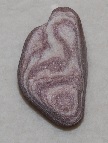
|
42a.
"Madonna" (height - 7.3
cm) - cobble of sandstone (Potsdam Sandstone) found in
cobblestone-veneered landscape highlight in Alexandria Bay,
Jefferson County, New York. This stone is Potsdam Sandstone,
which is the bed rock of relattively large areas within the region (The
St. Lawrence River Lowlands). That rock is one
of my favorites because the formation is the cellar floor of my
parents' home while I was a youth; our water came from a well in
the
formation; ripple surfaced flagstones, which were among the
sidewalks of the village, provided exhilarating feelings and sounds as
I roller skated across them; it is the facing rock of the
church where my wife of more than sixty years and I were married;
. . .
The "Madonna" designation for this
mimetolith was suggested by our daughter, Krista. And alternative
name is "Stan Laurel, Winking."
|
 |
42a. "Chicken (width ~ 50 cm.)
and its eggs" - fieldstone, which consists largely of the the
granitic portion of a migmatite, that was collected from glacial
deposits. The "eggs," apparently attained their shapes during
glacio-fluvial transportation. All were collected by Gale
Willoughby in Isabella County, Michigan. (©
photo by Dick Dietrich). |
 |
42b. "American Indian grooved
axe head" (length ~ 20 cm.). This fieldstone
consists of grantic gneiss transected with quartz veins or granitic
dikelets, the latter of which were weathered in relief, likely before
it was carried by "Ice Age" glaciers into Isabella County, Michigan
where it was found by Gale Willoughby. (© photo by Dick
Dietrich). |
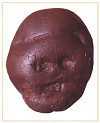
|
43. Makapansgat jasperite
cobble (height ~ 8 cm). This cobble is described as a manuport because
its diverse markings have been shown by "detailed microscopic analysis"
to be natural -- i.e., neither made by nor modified artificially. It
was found in South Africa at a site to which it was carried "either by Australophithecus africanus, or by
an as yet unknown hominid" "between two and three million years" ago.
Additional information and references about this cobble are on the web
site: http://mcw.vicnet.net.au/home/portable/web/manuport.html. (©
photo by R.G. Bednarik). |
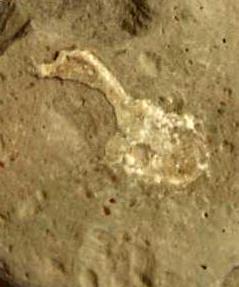
|
44a. " Duck" -
This bas-relief form, which resembles the
head and neck of a duck, consists of chert on dolostone. The
overall stone has a greatest dimension of ~7 cm. The
specimen was found by Mary
Margaret ("Diggy") Brown Clement in a deposit that probably represents
a former lakeshore environment in the area, now several feet above lake
level, near the Straits of
Mackinac, Michigan. (©
photo by Dick Dietrich).
|
 |
44b. "Frog" - i.e., a squashed roadkill(?)
frog (longest dimension of host cobble -- see clicked image -- ~16 cm), from
Rockport, Alpena
County, Michigan. This "frog" is a remnant of a fossil solitary
rugose coral; the cobble is a limestone with shale partings,
apparently
derived from the Devonian Traverse Group of
the Michigan Basin Sequence. The specimen was found by Elizabeth
Shaw Antkowiak in what I suspect is beach
desposit of ancestral Lake Huron when it was at a higher level during
post-Pleistocene isostaic rebound in response to deglaciation of the
region. (©
photo by Elizabeth Antkowiak). |
 |
45. "Samurai Stone" (greatest dimension
- 4.3 cm). The white exhibited by this limestone pebble, which
Maziar Nazari sees as resembling a 'samurai' (and our mutual friend,
George Robinson, sees as an 'angel'?), is the remains of the 'petals'
or ambulacral areas of the echinoid
Echinolampus sp. found in the Alborz Mountains, north of
Tehran, Iran. (© photo by Maziar Nazari, Azad University of
Ashtiyan, Tehran, Iran).. |
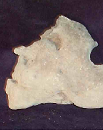 |
46. "The Nosey Neighbor"
(height ~11.5 cm) from a dry creek bed in Central Kentucky. (©
photo by Michael Capek, www.aestheticsense.org) |

|
47a. "Yonny" of
Hessel (greatest width ~60
cm). This dolostone boulder is between a summer home
and its parking area at Hessel, Mackinac County, Michigan.
It was apparently a residual boulder from a nearby field. ¶
The name was given because the stone resembles the so-named hand
puppet of Señor Wences (WENCESLAO
MORENO - 1896-1999), who manipulated his partly painted and clenched
left hand as Yonny's head as he and the puppet had conversations -- the
Señor with his
deep voice, the puppet with the Señor's high falsetta
ventriloquistic
responses .
|

|
47b. "Tough Guy"
(height ~5.5 cm). This
dolostone pebble was found at Hessel, Michigan (collection of Joan
Smith).
|

|
48. "Alien" (height ~3.8
cm). Found "among one ton of 'Scottish pebbles'
I bought for my garden... so ... must have come from Scotland if the
company followed trade description rules." (©
photo and quotation by Mark Cory) |

|
49. “Rocks with faces” - clicked image includes four of these
stones: A.“Sleeping rock,” B. unnamed (= the thumbnail), C.“The alien
and ” D. “A Picasso.” Each of these stones, which range from
small pebble to small boulder in size, was collected near Fanny
Bay, on the eastern coast of Vancouver Island, British Columbia,
Canada. (© photos by Glen
Peters, the collector)
|

|
49a This, as yet "unnamed" mimetolith is a rather large
stone -- greatest dimension makes it a small boulder -- that is on
the beach of Minas Basin, a northeastern section of the Bay of Fundy,
Nova Scotia, Canada. This
mimetolith and one or more of the stones of the preceding group of
stones (see 49) seem to provide mimetolithic"bookends" for our
northern neighbor, Canada. This one was found and photographed by
Paula Rockwell and forwarded to me by daughter-in-law Maria K.
Dietrich. (© photos by Paula
Rockwell).
|
New Group (4 October 2017): While selecting photos from
this web site (and two others) to prepare a booklet "Do You See What I
See" (Dietrich, 2017), the below mimetolith showed up, and upon several
closer looks at it, three different look-alikes (eac a head view) were
included -- i.e., by looking at the stone from different
viewpoints. Subsquently, other similarly double and triple view
mimetoliths have been brought to my attention by daughter Krista and
her good friend Mary ("Diggy") B(rown) Clement/ The first one so
seen follows this introduction; the second one follows it;
perhaps more will be forthcoming?!!

50a. "Three for one" - a
dolomite/dolostone cobble (greatest dimension - 21.5 cm).
from rubble at Boat Harbor, Gros Cap area, Moran Township,
Mackinac County.
50b. "Lady(on right) and her tree(left) and a
mushroom(center)" a
dolomite fragment (greatest
dimension - 9.7 cm) from Boat Harbor (same location as 50a). The
"tree" photo brought to mind the old saw "A bird in the the hand
is worth two in a bush." -- especially because Krista saw this as
a Christmas tree.
Others in the literature: The following
"hand specimen
size" mimetoliths do not fit readily into either of the above subgroups:
Aragonite, Barite and Gypsum roses -- for illustrations of these
features, see Figure 51, below, and photographs on the following web
sites, respectively --
math.cochise.edu/~mathsci/phpwiki/index.php/Aragonite%20Rose
&
www.greatsouth.net/p-.M102.html.
The fact that barite roses, sometimes called "rose rock," is the state
rock of Oklahoma is of interest so far as these "roses."
Concretions --
diverse concretions
such as imatra stones, which have been seen to resemble several things
such as buttons
(see Figure 52, below); so-called sand spikes from Imperial
County, southern
California (Sanborn, 1976, p.82); and septaria, of which
small ones have been
called "beetle stones" and larger ones, as "turtle backs" (see
Figure 53, below). Liesegang bands -- see Figure
55, below.
Pele's hair -- natural, typically brown-colored glass hairs some
with diameters
measuring less than a half millimeter and some with lengths measuring
up to a couple
meters (see Figure 56, below); an anecdote indicates how much
these may resemble
animal hair -- a handful I collected in Hawaii, before it became a
state, was shipped
along with several other rocks back stateside was confiscated
(apparently by a Department
of Agriculture inspector, who replaced it with a note to the effect
that "hair is
organic and can not be shipped into the United States"). Pele's
tears --
small nearly spherical or tear-shaped glassy masses commonly associated
with Pele's hair.
Several additional rocks exhibit diverse
mimicking forms and
"scenes;" a few are described and a few illustrated,
in the
"GemRocks" file on this web site -- e.g.,
see the
succeeding listed resemblance-based terms under in the following entries:
AGATE- eye,
oxeye, owl-eye, flame, fortification, frost, joshua tree, moss,
pagoda(stone), plume,
polka dot, pom pom, ruin, snake skin, star, topographic (also, photographs of a few of these are
also given in Appendix B of this file);
AMPHIBOLE ROCKS - Arizona
zebra stone; ARGILLITE - zebra rock; BRECCIA
- ruin
aragonite and ruin
marble; CHLORASTROLITE - turtle back;
CONGLOMERATE:
puddingstones;
DATOLITE - sugar stone;
THE
JADES - leopard, morning dew, moss in snow, snowflake;
JASPER -
leopardskin,
picture, poppy-patterned, scenic, zebra; LEOPARDITE and
LEOPARD
ROCKS;
MARBLE, . . . - landscape and ruin marbles and limestones;
OBSIDIAN - Apache
tears, peanut, snowflake; PORPHYRY - Chinese writing
stone,
chrysanthemum stone,
mouse-track porphyry, flowerstone (etc.); RHODONITE
-
spider web; RHYOLITE - birdseye; SANDSTONE -
picture, scenic;
SEPTARIUM - the
aforementioned beetle stones and turtle backs; TURQUOISE -
cobweb, spider web, and
turtle back turquoise matrix; [and] VARISCITE -
turtle back.
It also seems noteworthy that several fairly
common fossils or
their parts are frequently referred to by names of something they
resemble -- e.g.,
brain, chain, and horn corals, and Iowa's state fossil, crinoids, which
are frequently
referred to as "sea lillies." In addition, some scientifically
accepted
generic and species names have been based on things the fossils were
seen to resemble -- e.g.,
the bryozoan Archimedes (generic name), which has a shape that
resembles a device widely credited to Archimedes (ca. 287-212
B.C.) that was used in the mideast,
especially in
ancient Egypt, to remove bilgewater from boats and to lift
water from streams
to irrigate nearby lands (see Figure 57).
In addition, it should be recalled that a fairly
large number of
mineral and rock specimens have been identified as pseudofossils
because they resemble
certain fossils. -- The already twice-mentioned septaria, which have
been frequently been
misidentified as fossil turtles (see Figure
53), are but one example.
Miscellany
Click
thumbnails to see larger images.
|
 |
51. Gypsum rose, also called "Desert
Rose,"
as depicted on a Tunisian postage stamp. (© photo of
stamp by
Richard Busch, (see stampmin.home.att.net/), used by permission). |
 |
52. Imatra stones (Finnish - imatrankivi).
For untold decades, these mimetolithic "stones"
(a type of carbonate oconcretion) have been
characterized as petrified money (etc.)
and used as toys and trinkets (each named on the basis of its fancied,
imitative shape). Historically important lithographs and
heliographs and a photograph of a few of these concretions are shown,
along with their captions, when this thumbnail is clicked. |
 |
53. Septarium concretions, such as this one
(coin gives scale) in the Beaver Island Museum, St. James, Michigan,
have frequently been misidentified, and even mislabeled in
collections(!), as fossil
turtles. (© photo by David Darst). |
 |
54. "Twin Peaks," a concretionary mass of
calcite (greatest dimension ~ 7.5 cm) from Cretaceous shale
in the Shelby-Cut Bank area of northern Montana. This mimetolith,
Stewart Monroe's "worry stone," has been seen to resemble diverse
features including a pair of volcanic cones with breached
craters. (©
photo by Sue Monroe). |
 |
55. "Bull's eye" (diameter of outer ring ~
6.5 cm) liesegang rings or bands, which are the thin reddish brown
iron-rich (hematite and/or goethite and/or "limonite") zones in this
lighter colored sandstone, from an unknown locality. (© photo
by Sue Monroe). |
 |
56. Pele's
hair. "Hundreds of strands . .
. intertwined on the surface of a pahoehoe [ropy lava] flow at
Kilauea Volcano, Hawaii. The glass strands were erupted from Mauna Ulu,
a shield that formed on the east rift of Kilauea between 1969 and
1974." (http://volcanoes.
usgs.gov/Products/Pglossary). (photo by
D.W. Peterson, U.S. Geological Survey). |
 |
57. "Archimedes screw" - Top left, diagram of
water-screw invented by Archimedes about 2250
years ago (drawn after diagrams in a number of publications);
top right, sketch of Archimedes sp. , a bryozoan (redrawn after
sketch in
"North America index fossils," 1944 edition); bottom,
fossil and matrix (block ~13 x 8 cm) from Mississippian age
strata of Missouri. (© photo by Sigmund J. Kardas, Jr., used by
permission from www.kardas.net/Fos). |
 |
58. Sakura ishi - "Cherry Blossom
Stones" --
(average diameter ~6 cm) from Kameoka, Kyoto Prefecture,
Japan. Masutomi Museum specimens. The "stones" are sericite
pseudomorphs after sixling twins of cordierite; minor amounts of
hematite give the reddish hue evident in some of these
specimens [ see also, Koivula
(2015) ]. (© photo by John Rakovan).
|
 |
59. "Seahorse" -
This composite (height ~8 cm) consists of calcite crystals (back, etc.), calcite-cemented mud/sand
(body),
and part of a Mercenaria permagna (Conrad
1838) shell
(tail) from the Pleistocene Nashua Formation. It was
collected at Rucks' Pit in Fort Drum, Okeechobee County, Florida.
(© photo by Mickey Cecil) |
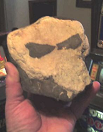 |
60. “Alien skull fossil”
- Calcite deposit on mudstone of the Jurassic-Cretaceous “Great Valley
sequence,” collected at Knoxville-Berryessa Road, Napa County,
California. (© photo by Marc Leukhardt)
|
According to Cook (2009), "One mineral club displays
annually at their local show an entire banquet table upon which all
food items are natural or sliced rocks and minerals; included are
ham, lamb chops, corn on the cob, potatoes, beans, yams, and on and on.
[And,] No table setting would be complete without flowers -- for
example, the wonderful barite roses from Oklahoma..." I have been
unable to find the name of the mineral club alluded to, but see
following Figures
Àlc....
À la carte
Click
thumbnails to see larger images. |

|
Àlc1B. "Soft boild egg" with a fire
opal yolk. This specimen of M. Budil, which is from Mezezo, Shewa
Province, Ethiopia, was exhibited at the Münchner Mineralientagen
2005; the large (clicked) photograph was originally published in
the Novembere Décembre 2005 issue of "Le Règne
Minéral" along with the following caption -- i.e., a free
translation of the caption: A welcome bit of humor that is one
of Mother Nature's marvelous constructions. -- You have to admit,
however, that if humans didn't eat soft-bioled eggs, this specimen
would be only an obvious banality.]]
(© photo
by Louis-Dominique Bayle; digital file furnished by
Eloïse Gaillou, gemologist at the University of Nantes;
reprinted here with permission from L.-D. Bayle). |

|
Àlc2B. "Grapefruit rock"
-- although "breaks in the 'segments' display a
reddish color, ... [and thus it is off-color so far as its
grapefruit-like appearance, this specimen (diameter
~13 cm)] resembles in size, shape ... a partially peeled
grapefruit with
five segments and a rind" (Robert
Mansfield, personal
communication, 2006).; found in the bed of Dry Creek, Hardin
County, Tennessee. In any case, the specimen "appears to
be the internal mold of a spatangoid echinoid" (J.Thomas Dutro,
personal communication, 2007). Fay
Myhan collection. (© photo
by Robert Mansfield). |
 |
Àlc3B. "Frosted
jelly-filled donut" ( diameter ~18 cm). This
fieldstone is
from glacially
transported debris in eastern Michigan. The parent rock was part
of the
Lorrain Formation of Ontario. The "frosting" -- suggested as
resembling strawberry cream -- is widely referred
to as jasper puddingstone. The rest of the stone is quartzite --
a
metamorphosed sandstone member of the formation. This stone is in
the collection of Patty Peek of St. Ignace, Michigan. (©
photos by Dick Dietrich) |

|
Àlc1L. "Bunyan's
burger" (height ~
1.5 m), also called "Hamburger Hill," is an erosional remnant (a
concretion, I suspect) in the North Coyote Buttes area of the Paria
Wilderness in northern Arizona. One story promulgated about this
mimetolith is that that Paul Bunyan dropped this sandwich when he
became confused during a sandstorm, and it subsequently was petrified.
(© photo by John Schwieder, www.wildernesspics.com). |

|
Àlc2L "Hot dog"
-- i.e.,
frankfurter/weißwurst (length -11.3 cm). This abraded piece
of a colonial coral (Class Anthozoa, Order Scleractinia) was picked up
from a "wash" on a beach on the south side of Aruba of the Netherlands
Leeward Islands of the south Caribbean Sea. (©
photo by Dick Dietrich). |
 |
Àlc3L
"Meatball sandwich" (width, as shown, ~ 20 cm), a loose stone that was
found by Holly Spurlock about three miles south of the Elk Creek, Glenn
County, California. It
consists of sandstone, the "bread" layers of which are well cemented
and hard whereas the "metaballs" are a softer sandstone. These
sandstones are part of the Great Valley Group (Stewart Monroe, p.c.,
2011). (© photo by Clara Osborne) |
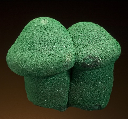 |
Àlc4L/1D.
"Malachite, mushroom-shaped
concretions, 7.0 x 6.5 cm, from the
mashamba West mine,
Kolwezi, Democratic Republic of Congo, Boniscoli specimen 4089".
Photograph previously published in "Rocks & Minerals" -- see
Pagano, 2014 in the References Cited. (©
photo by
Jeff Scovil). |

|
Àlc2D.
"Cauliflower florets" are frequently used to sample hors d'oeuvre
dips. These mimetoliths are the mineral kutnahorite (height
of larger one 6.2 cm ) from the Wessels Mine, Hotazel, Kalahari
Manganese Field, Northern Cape Province, South Africa; specimens
in collection of Becky Sterbentz. (© photo by Jeffrey A. Scovil,
jeffscovil@earthlink.net).
[This photograph previously appeared
in Scovil (2016).]
|
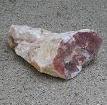
|
Àlc3D. "Leg of lamb
- with lots of fat" (length
~18 cm). This section of a quartz vein, with the "meat" surface on the
end
consisting of a natural "iron oxide" (hydroxide?), was found
in Fountain Hills, east of Scottsdale, Arizona. (Unlike the fare
represented by the mimetoliths shown as
Figures Àlc3 & Àlc4, this one is for the
gourmet.) Mary Lofgren collection, Green Lake, Wisconsin. (©
photo by Maria K. Dietrich). |

|
Àlc4D.
"Baked potato, ready for sour cream or topping of your choice. This limestone beach
stone (length ~5 cm) was
found on the beach that is along the shore of Lake Huron on the
southern edge of the Rest Stop just east of the junction of Rte 48 with
Rte. 134. (©
photos by Dick Dietrich).
|
|
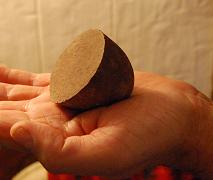
|
Àlc5D. "Half a
potato - plenty for some, better than none for others" (height, from
flat surface to top of "dome" ~ 45 cm). This stone is
quartzite apparently glacially transported into the area during the
late "Ice Age." Whether it was rounded before that transport or
later -- e.g., while it was on a beach of a higher level,
post-glacial phase of Lake
Huron -- and also the time and process(es) responsible for formation of
the flat surface
are unknown. In any case, that surface was present when the stone
was found by Edmund Massey in his garden in St. Ignace, Michigan;
the stone is now in his and his wife's collection of
stones.
(©
photos by Dick Dietrich). |
As already implied, mineral and rock specimens
the names of which
are preceded by color adjectives related to, for example, flowers (e.g.,
rose or
lilac) are not mimetoliths. Contrariwise, specimens that consists
of two or more
colors, the patterns of which resemble some animate or inanimate
object, are mimetoliths
-- see definition 1.b. Three examples are 1) graphic
granite, also known as
runite and by similar names in several non-English languages -- all
names are based on the
fact that this
rock,
which consists of
quartz "rods" within a continuum of a potassium feldspar,
exhibits a
pattern that roughly resembles letters of cuneiform inscriptions or
letters of the Hebrew
or Arabic alphabets when cut perpendicular or nearly so to the lengths
of the rods (see Figure A in the GRAPHIC GRANITE entry of the GEMROCKS FILE as well as
Figure 32 in this file). 2)
Orbicular
rocks, the orbicules of which have
certain arrangements -- when broken or sliced these rocks may
exhibit forms such as those shown in Figure
31 and in Figure D in the GRANITE entry
in the GEMROCKS file.
[and] 3) Kikkaseki, the Japanese name of which translates as
"stone/rock of
chrysanthemum flowers" -- as can be seen (Figure 39), the
designation is quite
appropriate. The spotted olivine gabbro called troctolite (from
the Greek),
forellenstein (German), or troutstone (vernacular English) is another
fairly well-kown --
at least by petrographers -- example; each of these names
directs attention
to the rock’s appearance, hand-specimens of which are typically
speckled "like a
trout." In addition, I cannot resist mentioning one of the
most
intriguing rock specimens I have ever seen: It is a hornblende
syenite pebble that
exhibits many diverse mimicking images, some consisting of dark
hornblende surrounded by
light pink feldspar, others the feldspar surrounded by the hornblende,
still others
involving both minerals so-to-speak in concert.
Calling specimens, such as the agates and jasper shown as Figures 61 through 79,
mimetoliths appears to pose a problem for some people:
They consider the fact
that most such mimicking images have become apparent as the result of
chance cuts by
lapidaries rather than as the result of natural weathering to be
unacceptable so
far as calling these specimens mimetoliths. In my opinion,
their problem is
unfounded -- see definition 1.b. and the discussion
at the end of the
definition. To elaborate further on the essence of this "problem"
--
these features, most
of which have "come to light" as the result of chance
(so-to-speak
random), rather than predictable, cuts could have been exhibited as the
result of
weathering and erosion (e.g.,
see Figures 41 through 48 + 90); that is to say, the features were
there(!!) --
they were only exposed, not put there, by the
lapidary. Along
this line, a lapidary, who had a rather sizeable display of such
agates, told me that he
was sure he had been predestined to find such agates and to make the
correct cuts to find
images they held. It seems especially noteworthy here that the
history for the
"owl" exhibited by the specimen shown as Figure 71 indicates its
recognition was
exceptional: "It was sold as rough material ... broke along
a fracture
plane ...[and it was] recognized that there was some form of pattern in
[it, so the
purchaser ] elected to grind the specimen instead of cutting it
with a saw.
The more he ground ... the more prevalent the image of the owl
became." ( Brad
Cross, personal communication, 2005). Also noteworthy:
Gabriele Berndt sent
photographs of additional agate slabs -- e.g., those that resemble
"two roosters," a "little white dog" and a "dragon" -- I
chose the ones shown as Figures 71, 73, 74 and 79 as my
favorites; and Bob
Beudry shows several agates, which he calls "Picture
agates," that exhibit mimetoliths on his web site (www.fireagate.com)
-- e.g., those that resemble
an owl, deer, fish, sad clown, and even an eight-ball -- of which my panel and I chose
the two shown as Figures 72 and 76 for inclusion on this site. In
addition, it should be noted that some mimetoliths of
this genre have been discovered by people while slicing and
polishing
thunder eggs.
Agates (See
also Appendix B.) and Jasper
Click
thumbnails to see larger images.
|
 |
61. "Virgin Mary"
(height - 14 cm), a "Condor Agate," is from San Rafael , Mendoza
Province, Argentina. www.rexpler.com.ar
collection.
(© photo
courtesy of the Birnies). |
 |
62. This "Modernistic bust that
so much
resembles
early Cycladic [southeastern Greek] sculpture was
discovered when an agate boulder was cut and polished" (size not given)
- quotation from Hurlbut (1970/1971); others -- e.g., Craig Gibson (personal
communication, 2006) -- see it as looking "a bit like Munch's 'The
Scream'." (photo by
David Brittain: The 35mm
transparency used for this scan is one of several that David
Brittain, former CMU photographer (now deceased), obtained permission
from Louis Zara (1910-2001) to reproduce from his Mineral Digest for my use.). |
 |
63. "Japanese Print" - Deschutes
jasper from north-central Oregon
(height - 5.0 cm). (© photo
by Kevin N. Daniel). |
 |
64. "The [Comedy] Mask"
(diameter - 6 cm) agate from a gravel pit near the Uruguay River in
Province
de Entre Rios, Argentina. www.rexpler.com.ar
collection.
(© photo
courtesy of the Birnies) -- A correspondent suggests that
it "looks more to me like 'The Joker' from the Batman series and movies
-- [especially like] Jack Nicholson in the role from the 1989 movie." |
 |
65. "Hear Ye?"
- ear-shaped agate (height ~ 5 cm). This
cut and polished Lake Superior agate from Keweenaw
Point, Michigan, along with its uncut bottom area, roughly resembles a
human
ear. Seaman Museum, Michigan
Technological University. (©
photo by John Jaszczak;
specimen collected and polished
by Robert J.Barron). |
 |
66. "Laughing Cyclops" [i.e., "Cíclope Sonriente"]
(diameter - 8 cm) agate from Neuquén Province, Patagonian
Region, Argentina. www.rexpler.com.ar
collection.
(© photo
courtesy of the Birnies). |
 |
67. “Leaping Lena, the cloud-hopping
angel” – notice that her name, spelled backwards (i.e., an[g]el) emphasizes
her status –
(egg height - 8 cm). The white form has also been seen as
resembling a youngster with water wings jumping into a body of water.
(© photo by Claude Pelisson, http://www.oeufspolis.com/a_/info.html). |
 |
68. "Face" (width
~ 10 mm). Jasper from the Urals, where the Russians call
it "agate-jasper." Cut and polished by goldsmith Vasili
Litchidov, now in the Netherlands, while in Uzbekistan (formerly USSR).
(©
photos by Vasili Litchidov). |
 |
69. "Beach Scene" agate as
pendant
(height - 3.5 cm), set in sterling silver. Beach with sporadic
brownish material (seaweed? and/or jetsam? and/or whatever?), bluish
sea and puffy clouds in the lighter colored sky above the
horizon. (©
photo by Lori Provo Coogan). The clicked image has the pendant
tilted so the "horizon" is nearly horizontal. |
 |
70. "Paradise Island" agate from
near Nuevo
Cassa Grande, Chihuahua, Mexico. This cloud-topped island
is, as can be seen on the complete specimen, which is shown tilted so
the coastline is horizontal, as the "clicked"
image, is a fine cabochon (width - 5.2
cm). (© photo
by Dave Salyer). |
 |
71. "Horse head" (height of slab
-11
cm) agate from quarry Setz, Steinbach, Germany. (© photo
and
sketch on large image by Gabriele L. Berndt) |
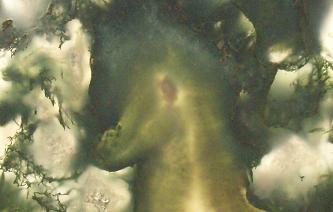 |
71a. "Horse"
included
in green moss agate from India ( height of slab shown in
clicked image ~7 cm). Owner sees this as a horse
swimming through seaweed. . (© photo by Michael P. Sousa) |
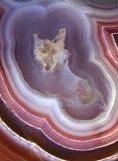 |
72. "Coyote on Indian blanket"
(width of specimen shown on clicked image, which shows complete slice
framed by purple heartwood ~15 cm) Laguna agate.
Collection of Bob Beaudry,
Tucson, Arizona (© photo by Joseph J. Intili). |
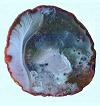 |
73. "The Feather" (height of
specimen - 4.9 cm) agate from Sidi Rahal, Morocco. (© photo
by Gabriele L. Berndt). |
 |
74. "Bird" (height of
specimen - 6 cm) agate from Neuquén Province, Patagonian Region,
Argentina. (© photo
by Gabriele L. Berndt). |
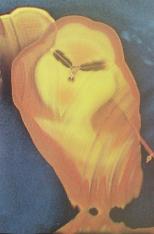 |
75. "Apache Hooded Owl" (height
of
"owl" ~ 5 cm) agate from Rancho La Vinata, Ejido el Apache, Chihuahua,
Mexico; Brad L. Cross collection. Photo (and piece), which
"have not been 'retouched' in any way. [i.e.,] It is
100% natural." is part of announcement in "Rocks & Minerals" (80:45)
of the 2005 (42nd International) Mineral, Gem and Fossil Show in
Munich. (© photo by Wayne Baker; permission
B.L.Cross; courtesy of Johannes Keilmann, Show coordinator). |
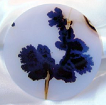 |
76. "The Blue Rooster" or "The
Rooster
Crowing at the Sun" (diameter of piece ~ 5.3 cm) plume agate
from Hindus India Valley,
India -- mined in 1996 and bow cut. Collection of Bob Beaudry,
Tucson, Arizona (© photo by Joseph J. Intili). |
 |
77. "Praying Mantis" in
Morrisonite jasper from south-eastern Oregon
(greatest dimension 3.0 cm). (© photo
by Kevin N. Daniel). |
 |
78. "Wheatgrass Flowers" -
Owyhee jasper from south-eastern
Oregon (height - 5.3 cm). (© photo
by Kevin N. Daniel). |
 |
79. "The Roller-skate" (width of
specimen - 17 cm) agate from Agùa Nùeva, Mexico.
(© photo
by Gabriele L. Berndt). |
Mimicking appearances of a few so-called
mimetoliths of this
size-group have been enhanced by dyeing and/or reshaping -- for two
examples, see those
that look like diverse foods that are illustrated in color in "A
Thanksgiving I'll
Never Forget" (see Cancalosi, 1990), and also those shown in the
article "This
Food's . . . a Rock Solid Hit" (National Geographic
World,
October 1990). In the latter, several rocks and minerals that
resemble well-known
foods are shown, but several have had their shapes modified so
should not be
considered to be mimetoliths per se. Yet another group
of specimens
that might be, but should not be named, mimetoliths comprises the
"alphabet agates (etc.)"
described and illustrated by Laurs (2003);
the shapes of
these letters (etc.) were fashioned by creative cutting of
agates the layers of
which were selectively stained.
Earlier designations -- In 1993, Edna
Hesthal of Santa
Barbara, California and Tadao Okazaki of Hobara, Fukushima, Japan
independently directed
my attention to Suiseki, of which I was unaware before their contacts.
The definition for
Suiseki given in a Japanese dictionary (translated for me by Okazaki)
is "A stone or
a piece of rock for aesthetic appreciation. Usually displayed on a
water-filled tray or a
stand; [an] 'ornamental Stone'." And, apparently this
"art" has existed for untold centuries in Japan. In any case, it
seems to me that they are much more than the dictionary
indicates. At least they have evolved to included several other
things -- i.e., the photographs of suiseki sent to me by Hesthal, who
calls them
"viewing stones," resemble panoramic landscapes, other natural shapes
such as complete or parts
of
animals or vegetables (e.g., potatoes), but many are, in my opinion,
better characterized as abstract. Only a few that I have seen
either directly or in photographs are what I would call mimetoliths --
for examples, see Figure 80. Attention is also directed to the
polished marble pieces, widely referred to as "Dreamstones." Apparently
dating to the Tang Dynasty (618-907), these polished pieces are
described as "Amazing natural art ...[that] are unique pieces of stone,
primarily marble, ... from Cangshan Mountain in Yunan Province,
China. ... [that are] revered for their captivating imagery...
[-- e.g., ] their incredible depictions of the three-dimensional world
, for their colors, their beauty, and their symbolism." (International
Dali Dreamstone Association)
Suiseki that are mimetoliths
Click
thumbnails to see larger images.
|
 |
80. Suiseki. left. top, sea horse's head;
bottom, "lizard stone." (top © photo by Sally Gilmore;
bottom © photo by Edna Hesthal; both courtesy of Edna
Hesthal); right. top, snow-capped mountain
(base sawed); bottom, desert landscape. (© photos by
Sally Gilmore, courtesy of Edna Hesthal). |
Anyone who wants to learn more about Suiseki
could begin with the
web site www.bonsai-nbf.org,
continue by looking at another web site
(www.felixrivera-suiseki.com/),
etc. The latter site
provides text and
illustrations relating to the history and several other aspects of this
"art." For example, I found that "Japanese formalized the
art
of suiseki by naming various rock forms and creating precise ways to
display them. [and
that] Stones of great beauty were cherished and placed in a Tokonoma
(viewing alcove) to
be contemplated. [because] It was thought viewing of suiseki helped
stimulate the person,
purify one's soul and uplift one's spirit."
Some suiseki have been modified by, for example,
sawing to give them
a flat base. Some so-to-speak purists consider such suiseki to be
inferior to those
that have not been so-altered. In my humble opinion, this seems
like ridiculous
hair-splitting. Among other things, virtually all suiseki that
have sawn bases could
be mounted to show the same characteristics without being sawn.
It also is noteworthy that such terms as
anthropomorphic-, biomorphic- and zoomorphic-FORMS and quasi-(e.g.
bird-)like figures have been given some mimetoliths. However,
these terms have also been applied to all sorts of other things and
meterials. For some of these that are, and others that are not,
mimetoliths, see Day (2003?).
Also, as one might expect (?!?),
(wo)man-fashioned
mimetoliths are on the market -- e.g., see
wwwgiltedgegoblins.com.
MICROSCOPIC
FEATURES
Microscopic portions of some rock and mineral specimens
constitute
mimetoliths, a few in the same sense as
the mimetoliths shown as Figures 81 through 85
-- e.g.,
Figure 82.
Micro-mimetoliths
Click
thumbnails to see larger images.
|
 |
81. Aragonite and siderite "flower" (diameter
of "flower" ~ 5 mm). Specimen from Chastriex, Puy de
Dôme, France. Josselyne Salle Collection. (©
photomicrograph by Robert Vernet). |
 |
82. "Praying Innocent"
chondrodite
surrounded by a phlogopite-rich area (field ~ 1 x 1.5
cm).
Part of a thinsection of the impure marble that
occurs near the southern contact of the the Fish Creek phacolith of
Macomb township, St. Lawrence County, New York (Dietrich,
1957). (©
photomicrograph by Dick Dietrich). |
 |
83. Bird-like
inclusion in a diamond. The "overall inclusions scene (~1
mm long) [that] shows a striking resemblance to a bird in flight" that
is "composed of a mineral (probably garnet) ... surrounded by tension
fractures." (Laurs, 2008). (© photomicrograph by Lori Provo Coogan, Cohasset
Jewelers, Cohasset, Massachusetts).
|
 |
84 "Bibendum," the Michelin Man
(height ~1 mm). This individual is more than four times
the size of most
of those found; this is quite apparent in the left hand
image one sees when this thumbnail is clicked. All these masses,
which are kerogen, are from the Antrim Formation, near Traverse
City, Michigan. (see Dietrich and Chyi, 1995). (photo by David Darst). |
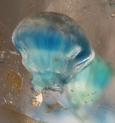 |
85. "Medusa quartz" -
Jellyfish-shaped masses
of gilalite (Cu5Si6O17·7H2O)
like this one occur in quartz
from Paraíba State, Brazil (Rondeau & Macri,
2005). Collection of Michele Macri, Italian gemologist.
(© photomicrograph by Benjamin
Rondeau, Museum
National d'Histoire
Naturelle, Paris, France). |
Others in the literature: Three other
microscopic features
that may be considered mimetoliths are 1. "Whimpy" (also called
"hamburger-on-a-bun") inclusions in Mexican opal -- see brief
description and
illustration in Crowningshield (1965); 2. a blue chalcedony that
contains several
red "inclusions" that is described in a news item in Volume I (1935,
p.196) of Gems
& Gemology as "'Blue Eagle chalcedony' ... because of
its natural
resemblance to the blue eagle emblem of the N.R.A. ... "
[and] 3.
the "Apollo space vehicle," an otherwise unidentified inclusion in
amethyst,
mentioned and illustrated by Liddicoat (1968).
ENHANCED(?)
MIMETOLITHS and MICRODRAWINGS
It appears that some mimetoliths
have had their similarity to something known enhanced. Though
none of the following ones can be definitely said to be such, it seems
likely that each has been so modified.
Enhanced(?) mimetoliths
Click
thumbnails to see larger images.
|
 |
90. "The Soul Stone" (height ~ 7 cm),
quartz-veined biotite gneiss cobble, described as a natural
cameo, was found in a back country stream southwest of Burnsville,
northwest of Mt. Mitchell, Yancey
County, North Carolina. Several viewers have suggested that this
figure
resembles the "Bride of Frankenstein" (1935) as played by Elsa
Lanchester. L. D. Fink who found the stone,
named it on the basis of its "mystical appearance" but adds that it
also looks like an Egyptian or Hun lady
who is looking at you over her shoulder. (©
photo by Lewis D. Fink). Mark S. Frumkin, a professional
jeweler and trained in hand engraving who has examined the stone,
thinks the pattern was hand enchased by someone using metal tools --
But, "the graver marks I found seemed to me to be as old as the
piece, almost as if it were done in another age or time. ... not
modern."
|
 |
91. Fish that, according to
Dr.
Cristobalo Campana (2005), had its eye and flipper "re-touched" by
pre-Columbian indigenous people to make its original resemblance more
obvious (Patricio Bustamante, personal communication, March,
2008). Further information is given (in
Spanish) on the following web site: http://rupestreweb.info/pareidolia2.html
(© photo). |
 |
92. Head of an eagle that, according to
Dr. Cristobalo Campana (2005), had its eye and beak
"worked" so its original resemblance to an eagle became even more
evident
(Patricio Bustamante, personal communication, March, 2008).
Further information is given (in
Spanish) on the following web site: http://rupestreweb.info/pareidolia2.html
(© photo). |
The well known "microdrawings" of the
volcanologist Alexander McBirney
provide another, though quite different, kind of enhancement;
His "microdrawings" based on a thin section of the Mt. Jefferson
(Oregon) andesite are especially noteworthy. They are on the
covers of two
publications of the Andesite Conference held in Oregon (McBirney, 1968
and 1969).
These sketches include two delightfully whimsical
"phenocrysts" -- see Figure 90. Although these particular
features were
fancied by McBirney -- i.e., they do not represent actual
grains in the andesite --
several imitative forms of the same genre have "struck me," and I
suspect
several other petrographers, while studying thin sections of diverse
rocks. (Strictly as
an aside: I lament the fact that with the introduction of
photomicrography,
drawing of relations seen in petrographic sections has become a lost
art. In my
opinion, such drawing led to insights seldom, if ever, gained by
clicking the shutter of a
camera. Indeed, I have even wondered if its demise had a role in
microscopic
petrography's becoming passé in many petrology laboratories.
But, that is another story.)
Microdrawings
Click
thumbnails to see larger images.
|
 |
100. Left. Airplane, inspired by the
Jefferson
Airplane Rock Group, which is near lower right of larger version that
is seen when this thumbnail is clicked. Right. Derek Bostok, bearded man with his
pipe, which is near center, right side of larger
version; he is, by the way, a "Self portrait" of the microdrawing
master, who "no longer uses a pipe!!" These diagrams are,
respectively, portions of the covers of publications of McBirney,
dated 1968 and 1969. (used with permission of A.R.
McBirney). |
SYNTHETIKITES
This
useful term, coined by John VonDerlin, was originally given to "manmade
rocks [e.g., diverse
bricks, ceramics,
concretes and slags] eroded
into attractive shapes." With his blessing, I extend his term to
include man-made materials that have been discarded and subsequently
rounded in
surf zones and stream
beds, thus leading to their being mistaken for natural pebbles and
cobbles. In addition, it would seem that concretes, polymers,
resins and fiberglasses that have been cast in
molds made of natural
cobbles and boulders -- and, in some cases, dusted with crushed rocks
-- and marketed for
various "stone uses" might be so designated because they too have
shapes that make them look like something else -- i.e., natural stones. Consequently, one probably
should
also add the relatively large surfaces that have been
plastered
with one or another these man-made materials in order to make the
resulting
surfaces appear to be boulders or rock outcrops (in most cases
to hide something
or to "create" the appearance of a natural environment). Whatever, several
additional
uses of such non-rock stones are mentioned under the subheading
"Pseudo-rocks"
in Chapter 3 of "Stones: . . . " (Dietrich, 1980
) and
under the subheading "Man-made stones" in the "Stones:
Addenda" file on this web site.
Synthetikites
Click
thumbnails to see larger images.
|
 |
110. "Little Devil" or "I didn't used to
look like this" [before the fight] (height
~ 5 cm) terrazzo. (©
photo by John Vonderlin).
|
 |
111. "Donald
Mitch-Hitchcock"
(height ~ 39 cm) exposed side of a faux stone in a masonry siding
on a residence
at Gros Cap, Michigan (©
photo by Dick Dietrich). |
This, of course, leaves
one group of specimens that appear to fit somewhere in between
so-to-speak typical mimetoliths and synthektites -- i.e., angular
fragments of rocks
such as granite and rock gypsum that have been roughly tumbled to make
them
rounded and thus
resemble natural pebbles. Is there any end to this? ? ?
ROLE REVERSAL IMITATORS
A genre of
"reversal of roles" occurs when people's eyes lead them to "see"
diverse non-rock entities as stones or rock outcrops. Two
examples come to mind: 1.The group of succulent plants called by
such names as flowering stone, living stones, stone plants, pebble
plants -- all (Lithops sp) --
that, except when in bloom, resemble pebbles with which, by the way,
they are commonly
associated, and 2. sheep on hillsides, usually fairy distant, that passers-by have
frequently misidentified as
boulders or outcrops
(and I might add,
pointed them out to their traveling companions!).
Thoughts about imitators such as
these have led to a
number of questions being sent to me -- most, I suspect, with "tongue
in cheek"
-- asking whether they should be termed lithomimetes (or
the like). --
My response is F0LDEROL! ! ! Call
them what they are.
ACKNOWLEDGMENTS
Frances S. Dietrich, Richard S. Dietrich, David
Ginsburg, Emmett
Mason, and J. Stewart Monroe critiqued different versions of the
manuscript and suggested
inclusion of some mimetoliths not treated in the versions they
read. Reed Wicander
identified the fossils shown in the "Loose stones" tabulation and
sought out the original photographs that were scanned to prepare some
of the
illustrations. David Ginsburg also helped me find some of the cited
references. The people
and organizations who supplied illustrations are noted in the captions.
I gratefully thank
all of these people for their contributions.
EPILOGUE
First, the rest of the original Introduction:
Also, consider the following poem (which reads in
part)
"Look, a cloud, the shape of a rose."
"Not so – it's either a seal
with a ball on its nose
or an elephant
balanced atop its toes."
"No, if not some flower,
it must be a large water tower
or perhaps an all-day lollipop."
"You both are wrong –
it's a
northern loon,
laughing straight up
at a
full harvest moon!"
. . . ."
and Dave Coverly's Speed Bump cartoon
(dated 11/16/2002),
which reverses the roles: two clouds are directing each
other's attention
earthward to a "lake [that] looks like an elephant" and a "clump of
trees
[that] looks like Peter Jennings." At about the same
time, an obituary
for the respected Harvard mineralogist, Clifford Frondel
(1907-2002), recorded the
fact that, after viewing a group of rocks brought back aboard Apollo
from the Sea of
Tranquility on the Moon, Cliff remarked, "It looked like a bunch of
burned
potatoes" (Long, 2002). Even more recently, Emmett Mason directed
my attention
to the July 21, 2003 entry on the web site
antwrp.gsfc.nasa.gov/apod/astropix.html
that showed a starfield
photograph by Gary Stevens
entitled "Reflection Nebula in Ophiuchius," which was described as
resembling
"an impressionistic painting?"; Emmett, however, wondered if it didn't
resemble
"a romanesque, goateed face -- maybe--eh?".
Is it any wonder that we, usually "down to earth"
geologists, when we look at certain topography, rock exposures, rock
and mineral
specimens, and beach stones sometimes think, "That looks like a ...
"? -- Certainly not!!! Imagination is not only one of
the
capacities that separates humans from other living beings:
It is common;
it is fun; and sometimes, as Burke’s (1940) lyrics go,
"Imagination is funny; it makes a cloudy day sunny . . ."
Consequently, it came as a surprise -- indeed, a
shock -- to me when
one of our would-be professional spokesmen dismissed practices
involving imagination
exercises of the kind just mentioned in rather negative terms:
". . .
faced with the history, the psychology, and the obtuse logic of
describing minerals in
non-mineral terms, one can only conclude that it will continue despite
any complaints. The
best defense may simply be to see the humor in it all" (Wilson,
1978). --
Fortunately, I think, Wilson's attitude is not held by many
Geoscientists (especially
educators). If it were, it might well serve to produce mental
blocks in the very
people whose curiosity, observations, and imaginations -- coupled with
their knowledge --
might otherwise formulate the new ideas and hypotheses that are so
important to the
advancement of our science. Along this line, see also
Appendix C.
Many of us who are active in one or more of the
subdisciplines of
this diagnostic science called geology have long acknowledged the need
for imagination as
well as knowledge. We recognize the fact that so-called
"uniformitarian
clues" are not the skeleton keys that open the doors of insight into
many important
questions. Consequently, we lament the fact that many youngsters'
imaginations seem
to be stultified by elders who prefer conformity. So, we
continually hope that at
least some of the youngsters who will become future members of our
profession will escape
such desensitizing "lessons."
Some of us even think: What better way to
escape such a dull
fate than to collect rocks and minerals and stones, and while examining
them to imagine
that some of their shapes or other features resemble something
else. Indeed, we
think it is fortunate that rocks and minerals can be enhancers of
imagination as well as
attractions for our future professionals. In fact, some of us
think this so-to-speak
practice can also be of value for adults. -- Along this line, I have
often wondered what
it was that so excited the imagination of Karl Harry Ferdinand
Rosenbusch, the
philologist, that made him change his profession, which ultimately led
to his laying the
foundations of microscopic petrography and becoming recognized as the
"Father of
(Modern) Petrology" (Dietrich, 1990); was it something he
saw while he
was teaching in Brazil, something he saw or heard while listening to
one of Bunsen’s
lectures, what ??
Some of us have tried diligently to find ways to
recognize and
attract students with good imaginations to our profession, and a few of
us have tried to
devise methods to enhance students’ imaginations. (By the way, the only
means I have
seen that seemed to help more than a few students was to have them
participate in some
hands-on Art (i.e., not art appreciation!) courses.) We
fully realized that
such efforts might lead to our losing some of those students; we
consoled ourselves
by thinking that should that happen at least those students would be
better prepared no
matter what career they might pursue. It is widely
recognized that
professionals from other fields as disparate as the visual arts,
engineering, literature,
and sciences other than geology also recognize the important role of
imagination:
The psychologist Barron (1958), for example, correlates imagination and
originality, which
he considers to be the foundation of a creative act; among
other things, he
concludes -- on the basis of a study of a group that included
anthropologists, biologists,
economists, painters, physicians, physicists, and writers --
"creative people
are especially observant . . . they value accurate observation
(telling themselves
the truth) more than other people do . . . they have more
ability to hold many
ideas at once, and to compare more ideas with one another – hence to
make a richer
synthesis." How can anyone doubt that these are the kinds of
people that we
need as petrologists, mineralogists, and other
geoscientists? Although
it is a bit out of the context of his use, I ofen think of John
Muir;s widely quoted statement:
"The power of
imagination makes us infinite."
(see
John of
the Mountains: the Unpublished Journals of John Muir, edited by Linnie Marsh Wolfe.
Boston, Houghton, Mifflin, 1938, p. 226.)
----------
>>>>>+++<<<<< ----------
Original Epilogue:
Two people who have apparently thought more
deeply about this
subject that I have, upon critiquing either the manuscript of the
column that appears in Rocks
& Minerals or a draft of the text prepared for this text,
brought up matters
that warrant recording:
A. Robert Cook (personal.communication,1988)
notes that imagination
for some people is probably much more than mere recognition that
something resembles
something else -- "It is the combination of observational talent and
the ability to
analyze observations to the point of recognizing such resemblances .
. . [that is
to say,] to recognize a real resemblance requires a certain degree of
analytical
thought."
B. Another reader of a preliminary draft of this
text thought that
something I told him, but did not plan to include, should be recorded
because "it
might prompt some social scientist(s) to make some sort of a follow-up
study that might
determine why observers have certain predilections so far as seeing and
identifying such
features." So, briefly, here are the two general relationships that
became evident to
me during my review of the mimetoliths. (It seems prudent to note,
however, that these
relationships, are based on a small sample and do not take into
account suiseki.
Also, not being a social scientist, I see no reason to repeat my
tentative interpretations
or conclusions so far as possible implications of these observations.)
1. A large
percentage of
recorded mimetoliths have apparently been thought to resemble human
beings or parts of
human beings. -- And, in order of reported abundance, other
mimetoliths, as I
mentally group them, are manufactured items (e.g., soda straws);
animals
other than humans . . . ; and plants and parts thereof (e.g.,
blossoms).
2. More
than seventy five
percent of the mimetoliths to which my attention has been directed have
apparently been
thought to resemble animate beings (i.e., animals including
humans) rather than
inanimate objects (i.e., plants and manufactured items).
ADDENDUM
When anyone perceives the shape or some
visual characteristic of a mineral specimen, a rock or a geological
feature to look like something else (i.e., to be a mimetolith),
that person is, according to some people, experiencing pareidoliatic
apophenia. Apophenia is the perception of connections and, in
some cases also meaningfulness, between unrelated things;
pareidolia is a specific kind of apophenia that involves some
relatively vague stimulus, visual and/or aural, causing a person to
"see" and/or "hear" something else. The Rorschach Test is
frequently cited as an example of this phenomenon, which is widely
characterized as psychological.
In my
opinion, the commonly published definition of pareidolia is
unnecessisarily restrictive
-- i.e., the "vague stimulus" should
include all the senses, NOT
just to those that are "visual
and/or aural". Certainly stimuli related to other senses also
lead to
people's thinking of something else!
One needs
only to think of experiences similar to those raised by questions such
as
the following:
Have you ever tasted something that made you think of
something else(?); have you ever smelled something that
made you
think of something diferent from the scent you are actually
perceiving(?); have you ever ...(?). I
suspect -- indeed, would be willing to bet -- that nearly everyone
would answer such questions in the affirmative; in addition, they
might recall having heard others say such things as "It
feels like ..." -- i.e., something different from what it
actually is. I rest my case.
REQUEST
Keep your eyes and
minds open: Look
and see and use
your imagination. Do not avoid recognizing mimetoliths just because
someone may consider
your doing so to indicate you are exercising "obtuse logic" or the
like.
Each mimetolith you conjure up may serve to improve your
imagination, your future
creativity, your future life . . . Imitator landscapes,
rocks,
minerals, and stones
are relatively common. Please let me know about
those you
find; I shall try to
continually update this web site file with some of the examples
directed to my attention.
REFERENCES
CITED
Barron, Frank. 1958. The psychology of
imagination. Sci. Amer. 199:150-166.
Burke, Johnny. 1940. Imagination (music
by Jimmy Van Heusen).
Sheet music. New York:ABC.
Special
attention is directed to the following, which is not cited with respect
to any of the photographs:
Bustamante D, Patricio,
Bustamante, Daniela y Yao, W. Fay. 2010. The worship to the
mountains:
A study of the creation myths of the Chinese culture.
En Rupestreweb, http://www.rupestreweb.info/china.html
Cancalosi, John. 1990. A Thanksgiving I'll never
forget. Ranger
Rick. November 1990, 24(#11):43-47.
Cook, R.B. 2009. Mineral oddities[:}
Theme of the 2009 Tucson gem & mineral show. Rocks & Minerals. 84:16-25.
Crowningshield, Robert. 1965. Developments and
highlights at the Gem
Trade Lab in New York. Gems & Gemology. XI:312.
Day, Alan.
2003? “Figure Stones” America’s (almost) invisible
prehistory Day’s knob in Guernsey County [Ohio]. www.daysknob.com/DG.htm (accessed 25
September 2009).
Dayvault, R.D. and H. S. Hatch. 2005.
Cycads from the Upper Jurassic and Lower Cretaceous rocks of
southeastern Utah. Rocks &
Minerals. 80:412-432.
Dietrich, R.V. 1957. Precambrian
geology and mineral resources of the Brier Hill quadrangle, New York. New York State Museum and
Science Service, Bulletin 354.
. . . . . 1980. Stones:
Their
collection,
identification, and uses (2nd edition). Prescott(AZ):Geoscience
. . . . . 1985. The tourmaline group. New
York:Van
Nostrand Reinhold.
. . . . . 1989. Imagine: Another
mimetolith. Rocks
& Minerals. 64:149-152.
. . . . . 1990. Are there patron saints
for rock and mineral
collectors? Rocks & Minerals. 65:442-445.
. . . . . and K-L. Chyi. 1995. Some
noteworthy minerals,
rocks, and crystals. Rocks & Minerals. 70:188-191.
. . . . . and
B.J. Skinner. 1979. Rocks and
Rock Minerals. New York:John Wiley & Sons.
Dubin, L.S. 1987. The History of Beads,
from 30,000 B.C. to the present.
New York:Harry N. Abrams.
Ham, W.E. and C.A. Merritt. 1944. Barite in
Oklahoma. Oklahoma
Geological Survey, Circular 23. Norman(OK):University of
Oklahoma Press.
Hurlbut, C.S., Jr. 1970/71. Quartz: The
story of one of the
earth's most important minerals and its precious varieties. Mineral
Digest. 1:62-73.
Hyatt, Akira.
2012. Mushroom pearl in G & G Lab
Notes. Gems
& Gemology. 48:211-212.
Ishihara, Nobuo. 1986. Kikkaseki. (circa
Stone/rock of
chrysanthemum flower). Tokyo:Bokujisha.
International Dali Dreamstone
Association.
2011-2012. I.D.D.A. International Dali
Dreamstone Association web site.
http://www.idda-us.com/index.html (accessed 25 June
2012.
Joy, Gordon. 1991. Letters to the editor. Scots
Magazine25 .
October 1991, 136(#1):8.
Kellogg, Marga. 2015. Inclusions come to
life in detailed photomicrographs. The
Loupe. 18:11.
Koivula, J.I. 2008. "Party"
diamond. in Lab
Notes 2008. Gems & Gemology. 44:257.
...................
2015. Trapiche muscovite. in G & G Micro-World. Gems & Gemology.
51:442-443257.
Koivula, J.I. and L.L. Dale. 2008. "Party"
diamond. in Lab
Notes 2008. Gems & Gemology. 44:257.
Koivula, J. I. and Maha Tannous. 2003.
Chrysocolla "owl" agate. Gems
& Gemology. 39:314.
Koivula, J.I. and Onstott, KF. "Unidentified
clarity characteristic" in diamond. Gems
& Gemology. 44:156-157
Kunz, G.F. 1913. The Curious Lore of Precious
Stones.
Philadelphia:Lippincott Company (Also Dover Publications:New
York, reprint.)
Laurs, B.M. 2003. "Alphabet" agates from
Indonesia. Gems
& Gemology. 39:153.
. . . . . 2008.
Bird-like inclusion in
diamond. Gems
& Gemology. 44:164.
Leibov, Michael. 2004.
Russian
gold: An overview. Rocks & Minerals. 79:156-173.
Liddicoat, R.T. 1968. Developments and
highlights at the Gem
Trade Lab in Los Angeles. Gems & Gemology. XII:348.
Long, Tom. 2002. Clifford Frondel, mineralogist,
examined first moon
rocks, 95 (obituary). The Boston Globe. November 15:D12.
McBirney, A.R. 1968. Andesite in thin section
(Cover picture) in
Dole, H.M. (editor). Andesite conference guidebook. Oregon
Department of Geology and
Mineral Industries. Bulletin 62.
. . . . . 1969. Andesite in thin section
(Cover picture) in
McBirney, A.R. (editor). Proceedings of the Andesite Conference.
Oregon Department of
Geology and Mineral Industries. Bulletin 65.
Monroe, J.S. 1987. Creationism, human footprints,
and flood geology.
Jour. of Geol. Ed. 35:93-102.
Nemirovskaya,
Alina and
Wuyi Wang. 2006. Diamond with unusual etch channel. Gems
& Gemology. XLII:165.
O'Neill,
Ian. 2015. Curiosity finds a 'Floating Spoon' on Mars. Discovery (Sept. 1, 2015) <
http://news.discovery.com/space/curiosity-finds-a-floating-spoon-on-mars-150901.htm
> (read, 2 September 2015)
Pagano,
Renato. 2014. The Tiziano Bonisoli collection Turin (Torino), Italy. Rocks and Minerals. 89:166-172.
Parrot, G.F. 1840. Recherches physiques sur les
pierres d'Imatra. Mémoires
de l'Académie Impérial des sciences de Saint
Pétersbourg. Sixieme Série, Tome
V, pt.2: 297-426.
Plaut, W.G., B.J. Bamberger and W.W. Hallo.
1981. The Torah: A Modern Commentary. New York:The Union of
American Hebrew Congregations. 1787p. [Plaut is both editor and author
of the commentary on Genesis.]
Rakovan, John, Masao Kitamura and Osamu
Tamada. 2006. Sakura ishi (Cherryh Blossom Stones): Mica pseudomorphs
of complex cordierite-indialite intergrowths from Kameoka, Kyoto
Prefecture, Japan. Rocks & Minerals. 81:284-292.
Ranzenberger, Mark. 2005. Nature's design: Family
finds rock shaped like Michigan. The
Morning Sun (Mt. Pleasant, MI). September
4:C1.
Rondeau, Benjamin and Michele Macri. 2005. "Medus
quartz" with gilalite inclusions. Gems
& Gemology. XLI:270-271.
Rosemeyer, Tom. 2010. Creede,
the last wild west silver mining campl in Colorado. Rocks & Minerals. 85:396-413.
Sanborn, W.B. 1976. Oddities of the
mineral world. New
York:Van Nostrand Reinhold.
Scovil, J.A. 2010. Scovil Unpublished
Favorites: 2009. Rocks &
Minerals. 85:134-139.
...................
2016. Some African beauties, a pictorial. Rocks &
Minerals. 91:308-314. .
Shaub, B.M. 1961. Seeing things in rocks and
minerals: Why. Rocks and Minerals. 36:233-234;
see also the cover photo.
Sheldon, J.M.A. 1900. Concretions from the
Champlain Clays of the
Connecticut Valley. Boston:The University Press, John Wilson
& Son.
Twain, Mark. 1971. The diaries of Adam and
Eve. New York:American
Heritage Press
Wilson, W.E. 1978. Hey, that looks like a . .
. In Notes from
the editor column. Mineral. Rec. 9:66-67.
Wood, R.W. 1917. How to tell the birds from
the flowers and other
wood-cuts. New York:Dodd, Mead and Co. (New York:Dover
Publications,
1959, reprint seen).
APPENDIX A.
Nouns
& Adjectives that indicate mimetoliths.
The widespread
occurrence of mimetoliths is clearly
indicated by several
terms that are rather widely applied by geologists, and a few of these
terms are also used by non-geologists. Also, if prefixes and
suffixes
used for minerals and fossils were included, several additional terms
could be listed. A few of the terms relate to senses other than
visual perceptions – e.g.,
singing sand relates to auditory
perceptions.
Some of
the more common nouns and adjectives that come to
mind are listed in alphabetical order in the following tables, with the
terms that originated as foreign words, but are used widely
in English-language publications, given in bold-face type. In addition,
special attention is directed to the adjectives given the agates
included in APPENDIX B.
Table 1. Nouns.
apron
arch
Archimedes screw
augen
biscuit (lake b...)
bight
blanket (ejecta b...)
blister (ice b...)
bloodstone
bridge
burr |
castle
cat’s-eye
chatter marks
cone (volcanic c...)
coral (cave c...)
cornice (glacial c...)
delta
dendrite
draperies
dollar (barite d...)
dome |
fan (alluvial f...)
fenster
flatiron
flax (earth f...)
float
flour (glacial f...)
flower (cave f...)
fold
gendarme
girdle
gold (fool’s g...) |
hawk’s-eye
hoodoo
horn
inselberg
kame
kettle
meal (glacial m...)
pearl (cave p...)
pillar (earth p...)
popcorn (cave p...)
pothole |
rose (barite
r...)
rosette (barite
r...)
saddle
spine
tiger’s-eye
towhead
tripestone
varnish (desert v...)
varve
wax (earth w...)
whaleback |
Table 2. Adjectives
& nouns used as adjectives.
bird's-eye (e.g., limestone)
accordian fold
armored mud ball
asparagus stone
augen gneiss
bird's-foot delta
box (e.g., canyon)
braided stream
brain coral
bread-crust bomb (etc.)
bridal-veil falls
cedar tree laccolith
chain coral
chevron fold
Christmas tree laccolith
|
concertina fold
cone in cone structure
crescent lake (etc.)
dog-tooth spar (calcite)
elbow twin
elephant-head dune
embossed
rock
en echelon folds
entrail pahoehoe
eye coal
eye & eyebrow structure
eyebrow scarp
fan coral,
delta, etc.
festooned pahoehoe
fishhook dune |
ghost crystal
glassy luster
hair pyrites, salt, etc.
hairpin dune
honeycomb weathering
horn coral
horseshoe reef
imbricated ...
jackstraw texture
Job’s tears
lacy residue
ladder vein, etc.
landscape sandstone, etc.
lard stone
layer cake geology |
mammillary ...
meandering stream
oxbow lake
pearly luster
porcelaneous...
pudding stone
recumbent fold
rice-grain habit
(smithsonite)
singing sand
snowflake obsidian
trellis drainage
trout stone
turkey-fat ore
vermiform
...
whistling sand
zebra rock |
APPENDIX B.
More Agates.
Commonly
applied names of many
agates are based on their patterns and/or
colors -- i.e., their names indicate things the agates
resemble.
Thus, these agates are mimetoliths. Examples of a few of
these agates
are illustrated in this appendix, and others -- such as mosaic
agate, pagoda stone, polka-dot agate, ruin agate, topographic
agate and zig zag agate -- will be added when appropriate photographs
become
available.
Blood agate -
blood-red, pink or salmon colored agate from Utah.
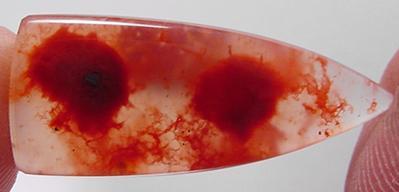 AppB1. "Pigeon
blood agate" (3.5 x 1.4, 0.5 thick) from Cisco, Utah.
AppB1. "Pigeon
blood agate" (3.5 x 1.4, 0.5 thick) from Cisco, Utah.
(© Sam Silverhawk, www.samsilverhawk.com).
Cloud
agate - light gray and off-white chalcedony with an overall
pattern
that roughly resembles clouds. Most examples I have seen have
shapes etc.resemble thunder
eggs.
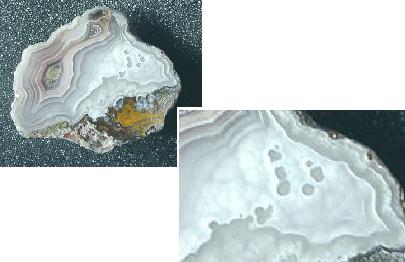
AppB2. Laguna Cloud
agate (width ~ 5.7 cm) from Chihuahua, Mexico.
(© photo by Wes Roth, www.opalcutter.com).Eye agate
- agate with alternating, concentric color bands. The terms orbicular
agate and Aleppo stone have also been applied to these agates, and
agates with two "eyes" have been referred to as oxeye and owl-eye
agates (cf. ring agate and
polka dot agate.). Eye agates
and ring agates (including onyx per
se) fashioned to form "eye beads" are said to have been used in
western Asia "since at least the third millennium B.C. as protective
amulets to deflect the evil eye or neutralize its effect." (Dubin,
1987, p.307).
AppB3. Eye agates. Lawrence H. Conklin collection.
(©
Lawrence H.
Conklin, www.lhconklin.com/bio/agat_col.htm).
Flame
agate - Two quite different agates have been called flame agate
in the
literature. Johnson and Koivula (1998) review and present fine
illustrations of both. The following, with pertinent quotations from
Johnson and Koivula (i.e., not
directely from Sinkankas and Macpherson)
briefly describe the appearances of these agates:
1. John Sinkankas (1959) described flame agate as a "highly
translucent, colorless agate with few typical agate bands, but rather
containing long streaks or 'flames' of a bright red color." The
material he described came
from Villa Ahumada, Chihuahua, Mexico. -- See Figure AppB4.a & b.
2. H.G. Macpherson (1989) applied the term flame agate to an
"agate of any color in which the pattern resembles a candle
flame." Many agates from
many worldwide localities, if correctly fashioned, could be designated
as flame agate under this definition. -- See Figure
AppB4.c & d.
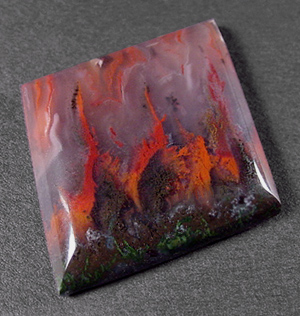
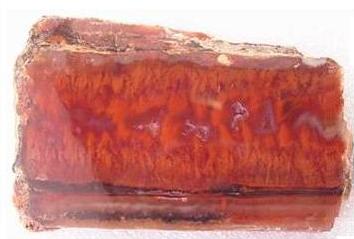
AppB4.a. Flame
agate (height ~ 3.8 cm) from "a remote vicinity near Sonora, Mexico."
(©
Sam
Silverhawk, www.samsilverhawk.com).
b. Flame agate polished surface (width ~ 6.5 cm) from Jimenez,
Chihuahua, Mexico.
(©
John Truax, www..mylittlerockshop.com).
AppB4.c. Flame agate
(height ~ 55cm) from Agate Creek, North Queensland, Australia.
Ashworths collection.
(©
The Australian Gemmologist, used by permission)
d. Flame
agate
(width ~ 4 cm) from Scurdie Ness, Montrose, Angus, Scotland.
(©
Hamilton Currie, www.durriehj.freeserve.co.uk ).
Fortification agate - agate
with bands that resemble bastions (etc.)
of
ancient forts -- cf. riband agate and ruin agate, AGATE entry
in
GEMROCKS file. Noteworthy
fortification agates have been collected from Fourth of July Peak, near
Hassayampa, Maricopa County, Arizona. The Fairburn agate, also called fairburnite, which is
the official state gemstone of South Dakota, is another fine
example of this kind of agate; it occurs sporadically in gravels in the Black Hills of South
Dakota.
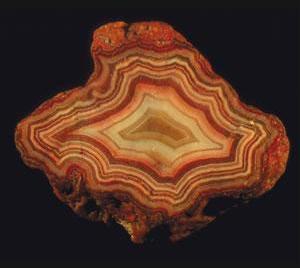
AppB5.
Fortification agate (width - info to come) from Black Hills of South
Dakota.
(©
Michael Carlson, www.agate-nodule.com ).
Frost agate (or frost
stone) - translucent gray chalcedony that contains sporadic
snowflake-like masses. A noteworthy occurrence is in the
Mojave
Desert of California. Having never seen the Mojave Desert
material or a photograph of it, I searched to find what I thought might
be so-named. The central part of the agate shown in Figure AppB6
resembles frost on windows and would seem to be a likely candidate for
such a designation.
AppB6. "Frost
agate" in the central part of a Lake Superior agate
(field width ~
3.5 cm), which probably consists of quartz crystals. Seaman Museum,
Michigan Technological University.
(© photo
by John Jaszczak).
Moss agate -
subtransparent to subtranslucent, white, light
gray, yellowish or greenish agate with green and/or brown to nearly red
iron oxide and/or black manganese oxide arborescent inclusions that
resemble moss, trees and/or landscapes. Some agates of this genre
have been
given additional adjectival modifiers that pertain to forms other than
moss that they are thought to resemble -- e.g., bouquet, flower,
landscape, seaweed, trees, and even gnat, midge and
mosquito. Diverse
moss agates have long been associated with Hindustan; Yellowstone
National Park, Wyoming; and the bed of the Yellowstone River in Montana
-- e.g., near Glendive, Dawson County, Montana.
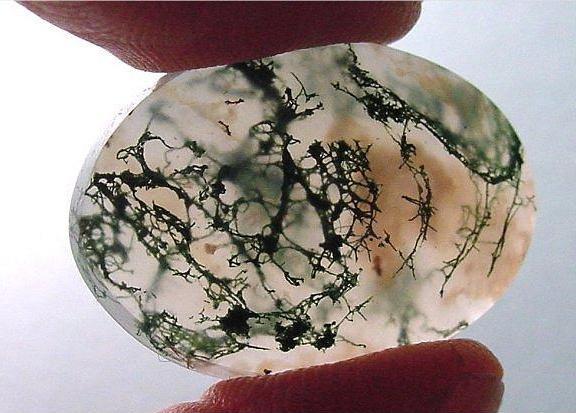 AppB7. Moss
agate cabochon (greater axis ~ 2.5, cm) from India(?). Sheila Demeritt
Collection.
(© photo
by Roger Weller, Cochise College).
AppB7. Moss
agate cabochon (greater axis ~ 2.5, cm) from India(?). Sheila Demeritt
Collection.
(© photo
by Roger Weller, Cochise College). Mushroom agate - cabochons,
beads, pendants have been marketed widely as as mushroom agate,
mushroom jasper and mushroom rhyolite, which is said to have been
metamorphosed. All, if indeed there are three differently
constituted ones, are said to come from Arizona. I have
seen only photographs of any of these, but all appear to be virtually
the same material. The photographs indicate that the pattern
of some of these pieces, as exhibited on polished surfaces, roughly
resemble mushrooms.
Plume agate - many
agates that are so-named are special kinds of moss agate. Most
consist largely of virtually
colorless or light-colored, commonly bluish, agate with included
sporadic red, yellow, yellowish brown or violet fluffy-appearing
masses, some of which resemble plumes of, for example, egrets. The
"plumes" of these
agates from several different localities have been recorded variously
as consisting of or pigmented by goethite, diverse individual manganese
oxides or
combinations thereof, realgar and/or orpiment. Some particularly
well-studied plume agate occurs within thunder eggs of Saguache
County, Colorado (see Figure A in THUNDER EGG entry, GEMROCKS file).
Other fine examples have been collected near Prineville, Crook County,
Oregon and south of Alpine, Brewster County, Texas.
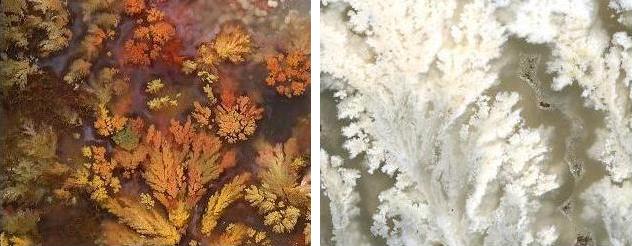
AppB8.
"Priday
Ranch plume agate" (field width ~ 1.8
cm) from Oregon;
b. "Stinking Water Plume Agate" detail (field width ~ 2.6
cm)
from Oregon.
(©
photos
by Hideharu
Yamada,
www.lithos-graphics.com ).
Pom pom agate - agate
containing pufflike clusters.
AppB9. "The Big Sky
Agate" - Pom pom agate
(width 22.5 cm) from Yellowstone River gravels
between Terry
and Miles City, Montana.
(©
photo
by Tom Harmon, www.harmons.net/bigsa ).
Ring agate - agate
exhibiting concentric
color bands -- cf. eye
agate. However, this designation is also used in the marketplace
for agates used in rings. As the pairs shown on Figure AppB9
indicate, the ring/eye-effect of at least some of these agates may be
just a result of the fashioned shape -- i.e., they may be typical banded
agates that have been cut to give the ring/eye appearance when viewed
in certain directions.
AppB10. "Ring agates"
(diameters ~ 2 cm). See preceding text.
(©
photos
by B. Alan Basinet , www..marbelalan.com/nonglass).
Snakeskin agate -
term applied to both silicified corals and chalcedony nodules whose
surfaces roughly resemble the scaly pattern of some snakes' skins --
see FOSSILIFEROUS ROCKS entry.
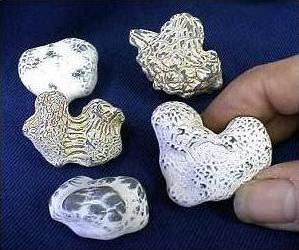
AppB11.
Snakeskin agate from the Mojave Desert in Arizona.
"These unusual agate specimens [i.e.,clear
to smoky chalcedony nodules] are not tumbled,
but are in the natural state in which they were found. ... erroded (sic) by
wind and sand while sitting atop the desert floor.
(©
photos
by Angi
Brown, www.greatsouth.net).
Nemirovskaya and Wang, 2006)
Sowbelly agate -
term applied to materials such as that shown by early miners who
thought it "resembled cured salt pork, a staple of the early miner's
diet; it consisted of fatty and lean layers of pork that was cut
from a sow's belly and sides. ...
[This] sawed specimen, which weighs 46 pounds and is 48 x 30 cm,
was recovered from the Last Chance mine dump [in the Creede mining
district in the San Juan Mountains of southwestern Colorado] (see
Rosemeyer, 2010).
The specimen is in
the collection of Tom Rosemeyer.
(©
photo
by Phil McCollum)
APPENDIX
C. Summary of a
pertinent report I did not see before I introduced the term
MIMETOLITH.
Benjamin M. Shaub,
then a professor of geology at Smith College, Northampton,
Massachusetts, and a man I knew during the first half of the 20th
century, when we were both doing geological work in northern New York,
wrote an article "Seeing things in rocks and minerals? Why?" that
was published in Rocks and Minerals in
1961*. A copy of the cover photograph of that issue of the
magazine is shown below
"An aggregate of smoky
quartz crystals
from
Perham Mine, West Paris, Me. ...
In collection of Mrs. Stanley I. Perham
at Trap Corner,
West Paris, Maine."
(no
dimension is given; photo copy of the
original cover
illustration; © 1961 by
Peter Zodac.)
The article starts out with the following statements:
"For some people, ...
it appears that their chief enjoyment in rocks and minerals is based
largely on what
objects they can see in the pieces that appear familiar to them when
they look at the various shapes and
configurations that these natural objects assume .... This game is so
intriguing to some of the members of
our mineral and rock fraternity that they specialize in collecting such
oddities. They have fun! And their
collections are the source of entertainment for their friends and most
visitors."
He also notes the following about the illustrated specimen:
"Let's look at the
cover photograph and Fig. 1. My friends tell me that the smoky
quartz crystals look like a
dog, others say it must be a mouse while others let it pass as an
animal with a stubby crooked tail and an
ear like a bat and resting on its belly with folded legs. Still
others say it is some sort of a rodent or if it did
not have such a long tail it could be a fawn. Another friend said
that it looks like some prehistoric monster,
and yet another remarked that if it were turned in a certain way it
'looks like my beagle'. What a beagle!
O.K., but why such uncertainty. The answer is that it only very
remotely looks like something, a mere
suggestion of a well known, object."
Dr. Shaub then goes on to describe virtually all parts of the
specimen in detail, and concludes that the owner of the specimen
"considers it a choice oddity. [and[ Such accessions add a great deal
of interest to mineral collecting and to one's collection. But do not
take them too seriously or read to much into their origin. It is
much better to learn the real nature of minerals."
* Marie
Huizing, Managing Editor of Rocks & Minerals,
kindly made an original copy of the 1961 issue available for
photography of these illustrations.
APPENDIX
D. Examples of Ice and Snow ?Mimetoliths?
Each of the
photographs in this appendix was taken by the compiler after the
question, given at the end of the Introduction was raised. All
were taken in Mackinac County, Michigan during the winter of
2013-2014.
25
December 2017 -- Boulder (i.e., a rock) plus Snow (i.e., a mineral) both that
fell and was blown; location Out my window, Gros Cap, Mackinac
County, Michigan.
APPENDIX E.
"No-Shows."
Some readers have asked
why I do not include photographs of certain mimetoliths to which they
have directed my attention -- i.e., those shown as photographs in
periodicals. Upon receiving such suggestions, I have looked at
each of the indicated illustrations. Those considered
good additions, and for which I have been able to get permission to use
the photographs, are included. Unfortunately, however, a few
photographs considered worthy of inclusion have not been added because
the
publishers were unwilling to give such permission. Examples
are:
1) the "Chrysocolla 'owl' agate"
(Koivula &
Tannous, 2003);
2) the one "resembling a palm
tree ... [that is an]
unusual etch channel ... in a 2.33 ct round brilliant diamond"
(Nemirovskaya and Wang, 2006);
3) the "minute crystal formation
(probably graphite) [which] is reminiscent of the 'flying saucers'
often featured in early science fiction movies ..." in a diamond
(Koivula and Onstott, 2008);
4) the "brownish green type1a
diamond
... [in which a] hydrogen cloud has a unique three-dimensional shape
reminiscent of a Venetian part mask" (Koivula and Dale, 2008);
5) the "columnar
play-of-color pattern resembling ferns ... in black opal from
Virgin Valley, Nevada" (Kellogg, 2009);
6) the "mushroom shape[ed pearl, which
has ] ... underneath the cap [has] ... arching radial structures
reminiscent of the 'gills' found in some actual mushrooms," (Hyatt, 2012 -- see Figure
7.)
| Top
| Home
|
R. V. Dietrich © 2018
Last
update: 14 January 2018
web page created by Emmett Mason
R.V
("Dick") Dietrich
(b. 1924), a native of the St. Lawrence Valley, Northern New York, is a
graduate of Colgate University (A.B.), and Yale University (M.S. &
Ph.D --
Geology). Now retired, he was a College
professor of Geology, with Petrology his main field of research. He has authored or coauthored many
professional papers and books, some of which are textbooks, and also 14
web
sites, most of which are available at http://stoneplus.cst.cmich.edu/Default.htm
.
For additional informaton, click the
following link: XXXX.
His
interest in Mimetoliths developed after he presented a "tongue in
cheek" talk about such features to a group of "Rock hounds."
This web
site was first prepared soon after the 1989 note about mimetoliths
appeared in Rocks
& Minerals. Subsequent additions of examples have been
selected from many that have been sent to him or solicited on the basis
of his seeing the photographs in publications.

